#fire nation navy vessel
Explore tagged Tumblr posts
Text
Black Ships
The Black Ships ( 黒船, romanized: kurofune, Edo period term) was the name given to Western vessels arriving in Japan in the 16th and 19th centuries.
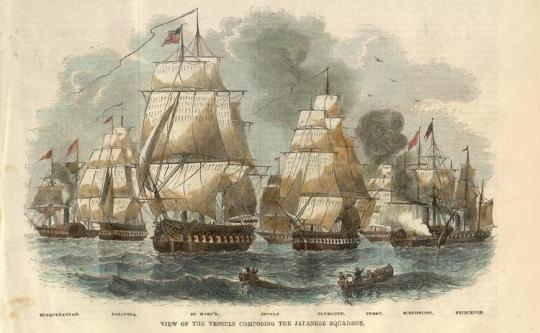
Commodore Perry's fleet for his second visit to Japan in 1854 - Engraving from Gleason’s Pictorial Drawing-Room Companion, Boston, May 15, 1852, Volume II, No. 20, page 305
In 1543, Portuguese initiated the first contacts, establishing a trade route linking Goa to Nagasaki. The large carracks engaged in this trade had the hull painted black with pitch, and the term came to represent all Western vessels. In 1639, after suppressing a rebellion blamed on the influence of Christian thought, the ruling Tokugawa shogunate retreated into an isolationist policy, the Sakoku. During this "locked state", contact with Japan by Westerners was restricted to Dutch traders on Dejima island at Nagasaki.
In 1844, William II of the Netherlands urged Japan to open also the mainland to trade, but was rejected. On 8 July, 1853, the U.S. Navy sent four warships into the bay at Edo and threatened to attack if Japan did not begin trade with the West. The ships were Mississippi, Plymouth, Saratoga, and Susquehanna of the Expedition for the opening of Japan, under the command of Commodore Matthew Perry. The expedition arrived on 14 July, 1853 at Uraga Harbor (present-day Yokosuka) in Kanagawa Prefecture, Japan. Though their hulls were not black, their coal-fired steam engines belched black smoke.
Their arrival marked the reopening of the country to political dialogue after more than two hundred years of self-imposed isolation. Trade with Western nations followed five years later with the Treaty of Amity and Commerce. After this, the kurofune became a symbol of the end of isolation.
#naval history#black ships#short overview#before i get the asks what they are#western vessels#japan#16th-19th century#more about perry soon#age of sail#age of discovery#history
64 notes
·
View notes
Text
It’s almost the end of my work week and to celebrate surviving my 3 AM shift, I’m posting a snippet from the one-shot I’m working on! The Sewell family is so intriguing to me and I’ve been playing around with them.
As expected, Natalie took to Persian as naturally as she had to every other language that was offered to her. Milton did his best, but like every other young boy, his attention was directed elsewhere: tales of glory and honor, and the maritime stories that only seemed to be rising in popularity.
News of Britain's colonies in the New World ignited fires in the imagination of its people. The continent across the ocean seemed to be full of possibility: pristine nature, opportunity ripe for the taking, if only one were brave enough to take to the sea to get to it. Milton, however, could not have cared less about the wild land that gripped the rest of the nation’s mind. Instead, he fixated on the large, wooden vessels that were needed to get there.
It frightened her, even if she did not speak of it. The ocean took just as easily as it gave. She knew that as well as anyone. The thought of her only son daring to leave dry land was unimaginable, for more ways than one. Thankfully, however, she was not the only one who abhorred the idea of it.
“I want to join the British Navy,” Milton announced one day at dinner, when he was all of thirteen years old. “I want to be a sailor.”
Her response was to narrowly miss choking on her venison, and she took a sip of wine to help recover. It was as red as blood, and the sight of it did little good, but it gave her time to think of what to say that did not betray the wrenching of her heart.
“You will do no such thing,” Lord Sewell said simply, as he sliced away at the meat, seasoned with a blackberry wine sauce, on his fine china plate. “You are the Sewell heir; heirs do not go to sea.”
“I’m not the eldest, though. Natalie is the eldest. Why isn’t she the heir? It doesn’t make any sense,” Milton protested.
“That simply is not the way things are done,” Lady Sewell managed at last. “But even if you were not destined to take your father’s place, you cannot be a sailor—it is far too dangerous, darling. I cannot bear the thought of you boarding a rickety, old boat, and sailing away from me.”
Milton seemed to take it as an affront. With an air of indignance that would only be mustered by a child of thirteen, he said, “They aren’t ‘rickety old boats.’ They’re the British Navy. They’re the finest ships in the world, and I want to command one.”
29 notes
·
View notes
Photo
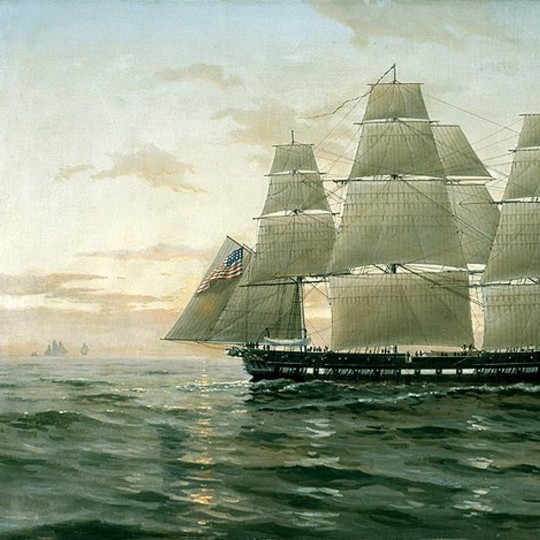
Chesapeake-Leopard Affair
The Chesapeake-Leopard affair was an incident that took place off the coast of Norfolk, Virginia, on 22 June 1807 when the British warship HMS Leopard fired on and boarded an American frigate USS Chesapeake while searching for deserters from the Royal Navy. The incident was one of the events that led to the War of 1812.
Background
In 1807, as the United States was still struggling to find its footing as an independent nation, the Napoleonic Wars were raging in Europe. Napoleon Bonaparte, having crowned himself Emperor of the French three years before, found himself opposed by a series of ever-shifting coalitions of European nations bankrolled by Great Britain. On land, Napoleon's armies had proved dominant; with such great victories as the Battle of Austerlitz (2 December 1805) and the Battle of Friedland (14 June 1807), he had conquered Central Europe and was now exerting influence throughout most of the continent. Britain, meanwhile, had smashed French naval power at the Battle of Trafalgar (21 October 1805) and was afterwards the undisputed master of the waves. This dichotomy left the neutral United States in a precarious position: to deal with one empire meant to upset the other. President Thomas Jefferson, nervously keeping tabs on the developments in Europe, voiced the concerns of many of his countrymen when he wrote: "What an awful spectacle does the world exhibit in this instant, one man bestriding the continent of Europe like a Colossus, and another roaming unbridled on the ocean" (Wood, 622).
But even as the war created anxiety in America, so, too, did it open the door of opportunity. American merchants were quick to capitalize on the gap in international trade caused by the fighting; with France and Spain no longer able to send merchant ships to their colonies in the West Indies, these colonies reluctantly opened their ports to American ships instead. The Americans would then re-export these Caribbean goods to European markets, making a fortune in the process. In 1807, the combined value of American imports and exports reached $243 million, turning the United States into the largest neutral carrier of goods in the world. When Britain complained that the United States' middleman trade strategy violated their so-called Rule of 1756 – which prevented nations from trading in times of war with ports that had been closed to them in times of peace – the Americans circumvented the rule by importing the Caribbean goods to the United States before re-exporting them to Europe, technically turning them into neutral cargo in the process.
American shipping would become threatened, however, as the Franco-British rivalry reached its stalemate. Unable to directly attack the British Isles due to the power of the Royal Navy, Napoleon decided to instead force Britain's submission by paralyzing its economy. In November 1806, he issued the Berlin Decree, the first block in his Continental System, in which he issued a continent-wide embargo on British trade. Any ship carrying British goods was liable for seizure, including those belonging to neutral countries. Britain retaliated with several orders-in-council, which placed a blockade on all ports that complied with Napoleon's embargo, stipulating that all nations who wished to trade at these ports had to first stop in England to pay transit duties. This, of course, left the American merchants in a difficult situation, as they could no longer trade at any European port without running afoul of either the French or the British. Before long, the warring empires were each seizing neutral American ships; between 1803 and 1812, France seized 558 American vessels, while the British captured 917.
Continue reading...
19 notes
·
View notes
Text
A Deadly "Peacemaker" and Unlikely Matchmaker: The Worst First Date Ever.
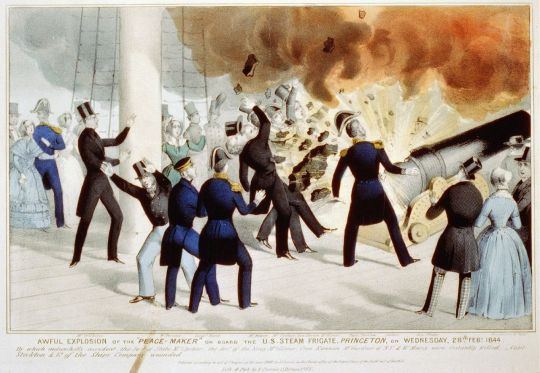
On February 28, 1844, Dolley Madison was far removed from her time as First Lady of the United States, but still held on to her spot as Washington's Greatest Hostess. She was the widow of a bona fide Founding Father, James Madison -- the 4th President of the United States and principal author of the U.S. Constitution and Bill of Rights -- but he had left the White House almost 27 years earlier and died in 1836. However, Dolley -- now 75 years old -- remained a darling of the Washington social scene. Though she often struggled financially, Dolley Madison continued entertaining guests in the nation's capital and helped organize social gatherings around the city, acting as a sort of guest hostess wherever she visited and whenever she was invited -- and she was invited everywhere. Now, as the first auguries of spring began their awakening in-and-around Washington, D.C., Dolley helped plan a cruise down the Potomac River on the newly-built USS Princeton -- a showcase vessel for the United States Navy which happened to be one of the most advanced warships of its time. Nearly 70 years after the Declaration of Independence, Dolley Madison was still the life of the party and an ideal person to help plan a celebration aboard the USS Princeton, just as she'd been doing throughout the entire life of the young American nation.

[Dolley Madison, daguerreotype by Mathew Brady in 1848, four years after the Princeton explosion.]
Launched just six months earlier, the Princeton was the U.S. Navy's first propeller-driven warship and its Captain, Robert Field Stockton, was proud of his charge. A cruise to demonstrate the ship's speed, capabilities, and weaponry to the Washington elite would be advantageous to the Navy's growth and to Captain Stockton's ambition. Besides Dolley Madison and the Princeton's crew of 178 sailors, the ship welcomed over 350 guests, including dignitaries such as Secretary of State Abel Upshur, Secretary of the Navy Thomas W. Gilmer, Secretary of War William Wilkins, Postmaster General Charles A. Wickliffe, Senator Thomas Hart Benton, and other diplomats and members of Congress. The most celebrated guest on the Princeton that day, however, was President John Tyler, who had also invited a young woman he had been romantically interested in, Julia Gardiner, and her father, David Gardiner, an influential New York lawyer and former State Senator.
Everyone on board the Princeton had underlying reasons for taking the cruise down the Potomac. For some, it was to see the Princeton for themselves. For others, it was because it was the place to be for politicians and diplomats on that February day. Some took the cruise for the opportunity to observe others, and some took the cruise in order to be noticed. The big draw, however, was a chance to see the Princeton's two large guns -- weapons so big and powerful that they were given their own names: the "Oregon" and the "Peacemaker" -- being fired. Both of the guns were impressive, but the "Peacemaker" was an amazing spectacle. At the time, it was the largest naval gun in the world. The ship was so new and the "Peacemaker" was so potentially devastating that, as of the day of the Princeton's cruise down the Potomac, the weapon had been fired no more than five times, according to Captain Stockton.
In February 1844, John Tyler was entering the final year of a contentious, controversial, and accidental Presidency. Elected as Vice President alongside William Henry Harrison in 1840, Tyler spent only a month in the Vice Presidency before President Harrison died in office. On April 4, 1841, Tyler became the 10th President of the United States, but his succession was not a smooth one. Harrison had been the first President to die in office and the Constitution was not specifically clear about Presidential succession. To many, including everyone in President Harrison's Cabinet, Tyler was still the Vice President and only assumed the duties of the Presidency, not the title or the privileges (such as living in the White House). At his first meeting with the men Harrison had appointed to the Cabinet, the Cabinet all but insisted that they would rule by committee and that Tyler had no more power or influence than, say the Postmaster General (which was a Cabinet-level position until 1971). Many Americans felt that Tyler was merely "Acting President," and that he was to defer to the will of the Cabinet on all issues.
Tyler vehemently disagreed and the manner in which he assumed office set a precedent that was followed by all future Vice Presidents and was eventually cemented into the Constitution. Tyler declared that he was not the Vice President or the "Acting President," but that Harrison's death had propelled him directly into the office of President of the United States to serve out the remainder of Harrison's elected term with the same powers and duties and privileges that come with the office. Tyler moved into the White House and, when his Cabinet balked at his assumption of power, he accepted the resignation of everyone but his Secretary of State, Daniel Webster (Webster eventually resigned in 1843).
President Tyler's troubles did not disappear once Harrison's hand-picked Cabinet departed or after Tyler settled into the Executive Mansion. The slavery question was tearing the nation further and further apart by the day. When Tyler won election in 1840 as Harrison's Vice President, he did so as a member of the Whig Party, but when it came down to Tyler's personal political ideology he was all over the political spectrum. As a younger man, he supported Thomas Jefferson and the Democratic-Republicans and he supported Andrew Jackson during Jackson's first term before Tyler became a Whig. Upon his Vice Presidential nomination, there were questions about Tyler's Whig credentials, but the Whigs needed a strong Southern balance on the ticket and accepted Tyler. But now that General Harrison was dead, President Tyler's independence frustrated his party, which felt that he was not sufficiently Whiggish. With former President Andrew Jackson out of the picture and retired in Nashville, and with Whigs in control of Congress and the White House, the party attempted to establish another Bank of the United States. The Whig Congress pushed through a bill creating a new Bank of the United States, but President Tyler definitively broke ranks with the party that had nominated him for national office and vetoed the bill. Twice. So, just months after assuming the Presidency, Tyler was expelled from the Whig Party and remained a President without a party until he left the White House in 1845.
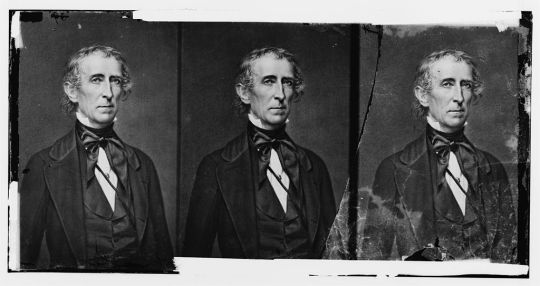
Now, on a warm day at the end of February 1844, Tyler was thinking about whether or not he would support the annexation of Texas. The President also thought of romance. In September 1842, Tyler's wife, Letitia, died in the White House after suffering a stroke. Tyler was still grieving when he began courting Julia Gardiner in January 1843. Tyler had met Julia while his wife was still alive, but he didn't become smitten with her until after his wife's death. Tyler and Julia kept their relationship guarded from the public and the President was even secretive about it to his (very large) family. Part of the reason for his reluctance to be open about his feelings was because Letitia had only been dead for a few months when he started dating Julia. However, a bigger reason was Julia's age. When they began dating, Julia Gardiner was just 22 years old. The 52-year-old President was wary about how his children (he and Letitia had seven children who lived to maturity) would feel about him dating a woman who was five years younger than his oldest daughter.
The age difference also worried Julia's family. Julia Gardiner was the daughter of David Gardiner, a wealthy New York lawyer and former New York State Senator. She was born in 1820 on an island in the Long Island Sound named after her family, and had everything that she wanted or needed while growing up on Gardiner's Island. Julia was beautiful and much in demand by the eligible bachelors of the East Coast. After meeting President Tyler, Julia first tried to reject his advances, but she was certainly intrigued by the powerful and charming Virginian. For his part, Tyler was madly in love with Julia and he first proposed to her in late-1843. Julia's mother did not approve of her daughter marrying a man 30 years older than Julia, so Tyler didn't get an answer. By inviting Julia and her father to accompany him on the USS Princeton, John Tyler hoped to show David Gardiner that he could impress the wealthy New Yorker and demonstrate that he could be a wonderful husband to Julia.

[Julia Gardiner Tyler, around the time of the Princeton explosion and her marriage to President Tyler, c. 1844]
••• Guests gathered at the Washington Navy Yard as ferries transported them across the Potomac River to Alexandria, Virginia, where the USS Princeton was anchored and ready for the afternoon cruise down the Potomac. As dignitaries boarded Captain Stockton's ship, they marveled at the size of the two guns on deck and examined every inch of the 164-foot warship. Music was provided by the United States Marine Band -- "The President's Own" -- and food was served below deck as the Princeton began its leisurely cruise down the Potomac. As guests explored the Princeton and watched the historic sites on both shores of the Potomac pass by, the massive "Peacemaker" gun was fired to the delight of everyone on the ship. The rounds fired by the powerful "Peacemaker" were capable of traveling up to three miles. As the warship cruised down the river the rounds that were fired were aimed at ice floes in the distance which were breaking apart as the afternoon sun warmed the Potomac. The cruise continued, with men mostly on the deck and pretty much all women below deck where food and drinks flowed freely, conversation was genial, and some of the guests were gleefully singing and clearly enjoying themselves.

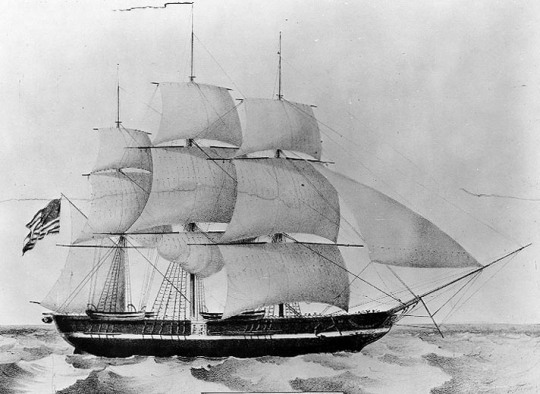
When the Princeton reached Mount Vernon and George Washington's sprawling estate came into view, the ship fired another round from the "Peacemaker" in tribute the first President and then turned around for the return trip to Washington, D.C. The Princeton's passengers had gathered below deck for celebratory toasts and to listen to the impromptu singing concert taking place in the salon. At around 4:00 PM, some of the men requested a chance to witness the "Peacemaker" being fired again, but Captain Stockton demurred, telling the men, "No more guns tonight." However, one of the men who wished to see the "Peacemaker" fired once again was Thomas W. Gilmer, the man who had become Secretary of the Navy just 10 days earlier -- a man who just happened to be Captain Stockton's superior. Gilmer's wish was something akin to an order to Captain Stockton, so Stockton headed to the deck and had the gun prepared to be fired once more.
Many of the men began heading upstairs to witness the firing of the "Peacemaker" while the women mostly remained below deck and continued with their songs and conversations. President Tyler was heading up the gangway plank towards the deck when he was told that his son-in-law, William Waller, the husband of his daughter Elizabeth, was about to sing one of Tyler's favorite songs. Instead of heading to the deck, the President headed back into the salon and was handed a drink. Upstairs, men crowded around the giant "Peacemaker" for one last demonstration of its firing power.
On the deck, Secretary of War William Wilkins jokingly told the spectators, "Though I am Secretary of War, I do not like this firing, and believe I shall run!" before moving to the far side of the Princeton. The remainder of the guests were close to the "Peacemaker" and the big gun was ready to be fired. The Princeton was about 15 miles downriver from Washington, D.C. and two sailors took the final steps for firing the weapon.
Suddenly, at 4:06 PM, a massive explosion rocked the Princeton and the deck was obscured by white smoke and an eerie silence. President Tyler rushed up to the deck to investigate what had happened, but what he found was a horrific scene. The "Peacemaker" -- the largest naval gun in the world -- had exploded at the breech. The powerful explosion tore part of the ship's deck and the "Peacemaker" broke into red-hot pieces of iron that flew into the crowd of spectators. Nobody downstairs was injured, but the deck of the Princeton was a place of horror. Eight people had been killed and 17 were seriously injured, including Captain Stockton and Senator Thomas Hart Benton. As President Tyler reached the deck, the silence turned to anguished screams and confusion.
The President fought through the smoke and found that the toll was high. Secretary of State Abel Upshur was dead -- literally disemboweled by the blast. Navy Secretary Gilmer was dead. The Princeton's Commander Beverly Kennon and two Princeton sailors were dead. American diplomat Virgil Maxcy was dead. President Tyler's slave, Armistead, who had requested and been granted permission from Tyler to view the gun as it was being fired was dead. And, finally, David Gardiner -- the father of the woman that the President hoped to marry -- was also killed by the blast, his arms and legs severed from his body by the force of the explosion. A tearful President was devastated by the loss of two of his senior Cabinet members, and he headed back down below deck to notify the women about what had happened. With dozens of victims and witnesses screaming, crying, and/or in shock throughout the ship, there was an attempt to keep most of the passengers below so that they didn't see the gruesome scene on the deck.
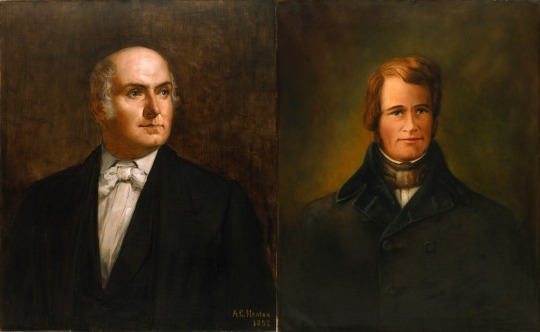
[Secretary of State Abel Upshur and Secretary of the Navy Thomas W. Gilmer, who were both killed by the explosion on Feb. 28, 1844.]
The smoke-filled deck of the Princeton was covered with blood, dismembered limbs, dead bodies, and stunned survivors, many of whom had been wounded by pieces of red-hot, iron shrapnel from the gun or pieces of human beings torn apart by the explosion. Throughout the ship, ears were ringing and people were rendered temporarily deaf by the sound of the blast. Below decks, the women who had accompanied the Princeton awaited more news from above, which quickly trickled downstairs. Someone yelled, "The Secretary of State is dead!" and the news did not improve. When Julia Gardiner found out that her father was among those who had been killed in the blast, she fainted -- directly into the arms of President Tyler. Dolley Madison, who had seen much in her 75 years -- during the War of 1812, she barely escaped the White House shortly before British forces captured Washington and burned the Capitol and the Presidential Mansion -- was certainly stunned by the tragedy aboard the ship, but she quickly did her best to comfort the Princeton's passengers who were shaken and distressed.
As the USS Princeton limped back to Washington, D.C., John Tyler comforted Julia Gardiner as best as he could. For the President, his pleasure cruise with the woman he hoped to marry and her wealthy father could not have gone worse. Now, David Gardiner was literally laying in pieces on the deck of the Princeton as Tyler -- who was also returning to Washington without a Secretary of State or Secretary of the Navy -- tried to console Gardiner's young daughter, but she remained unconscious until the ship arrived back in Alexandria, Virginia.
When the Princeton arrived at Alexandria, President Tyler physically carried Julia Gardiner from the wounded warship. On the gangplank, Julia finally awakened in the President's arms, and as she later said, "I struggled so that I almost knocked both of us off the gangplank. I did not know at the time, but I learned later it was the President whose life I almost consigned to the water." President Tyler had Julia taken directly to the White House where she spent the next few days recuperating under the watchful eyes of the President and his large family.
The bodies of Julia's father, the two dead Cabinet members (Secretaries Upshur and Gilmer), the Princeton's Commander Kennon, and the diplomat Maxcy remained on board the Princeton on the night of February 28th. The injured went to hospitals and homes around the capital city. The next day, Washington was in official mourning as the word of the tragedy spread and the signs of mourning -- black crepe hanging on the White House and other public buildings --were displayed. As Washington mourned, the bodies of Gardiner, Upshur, Gilmer, Kennon, and Maxcy were transported to the White House, where their flag-draped caskets rested in honor in the East Room. (It's safe to assume that President Tyler's slave wasn't awarded the same honors -- when the bodies were removed from the Princeton, they were all placed in magnificent mahogany caskets, except for Armistead, who was placed in one made from cherry. The President did reportedly give Armistead's mother $200.)
After two days of lying in state in the East Room of the White House, Gardiner, Upshur, Gilmer, and Kennon were transferred to St. John's Episcopal Church, where all of official Washington showed up to pay their respects at their joint funeral (Maxcy's family took his remains for a private funeral and burial shortly after his body arrived at the Executive Mansion). It was a solemn occasion -- one of the biggest tragedies to strike the United States up to that point, and a significant loss to President Tyler, both professionally and personally. Tyler was mourning two important members of his Cabinet, and the woman he hoped to marry was burying her father after he had been killed in the most gruesome manner imaginable on a cruise that Tyler had invited him to take.
The funeral started with an ominous and unfortunate signal: the firing of loud artillery across from the Executive Mansion could not have been a pleasant reminder to those who had survived the tragedy on board the Princeton a few days earlier. The bodies of Upshur, Gilmer, Kennon, and Gardiner were taken to Congressional Cemetery following the funeral and buried there, although Gardiner was later exhumed and reburied on Gardiner's Island in New York. After narrowly escaping death or serious injury on the Princeton a few days earlier, President Tyler found himself in danger once again as he left the funeral. Traveling through the busy streets of Washington in his horse-drawn carriage, the President's horses were startled by the crowds and bolted -- leaving Tyler helpless in a runaway carriage until a man bravely rushed out from a hotel entrance and helped stop the carriage.
••• Being comforted by President Tyler and his immediate family in the aftermath of her father's death changed Julia Gardiner's mind about marrying the much older President. Tyler had done everything possible to console her and make her feel safe in the days after the Princeton explosion. Later, Julia would write that, "After I lost my father, I felt differently towards the President. He seemed to fill the place and to be more agreeable in every way than any younger man was or could be." While the loss of her father was certainly tragic, John Tyler happened to be in the right place at the right time, and, in a strange way, David Gardiner's death may have helped spark the romance between the President and Gardiner's daughter. Several weeks after the Princeton tragedy, Tyler asked Julia's mother (who herself was nearly a decade younger than the President!) for her blessing to marry Julia and Mrs. Gardiner approved of the union.
Still, the marriage was not without controversy. The wedding took place on June 26, 1844, just a few months after the Princeton explosion. Julia and her family were still in mourning for Mr. Gardiner, so the wedding was solemn and low-key. Plus, the President's family -- particularly his daughters from his first marriage -- were reluctant to accept his new bride. After all, Tyler's first wife had died less than two years earlier, and Julia Gardiner was about the same age as Tyler's daughters; in fact, she was five years younger than Tyler's oldest daughter. One more unique aspect of the wedding was that this was the first time an incumbent President of the United States had ever gotten married while in office. Normally, it would be blockbuster social news, but the President's wedding was kept strictly private.
Accompanied only by his son, John Tyler III, the President and Julia Gardiner were married at the Church of the Ascension in Manhattan (which is still standing today, at Fifth Avenue and Tenth Street in Greenwich Village) on June 26, 1844. Very few people even knew that the President was in town until after the wedding when they heard the salute from the guns of warships in New York Harbor as he and his new First Lady departed the city (again, maybe firing the guns wasn't the greatest idea for this particular couple at that particular time?). According to one of the only eyewitness accounts of the wedding, published in The New York Morning Express the day after the nuptials, the bride was given away by her brother and and "robed simply in white, with a gauze veil depending from a circlet of white flowers wreathed in her hair." After the ceremony, the wedding party held a dinner at Lafayette Place before the President and Mrs. Tyler departed the city by steamer, staying the night in Philadelphia, before proceeding back to Washington on a special train the next day.

[The Church of the Ascension in Manhattan where President Tyler and Julia Gardiner were married on June 26, 1844.]
When President Tyler left office in 1845, he and his wife retired to Tyler's plantation in Virginia, Sherwood Forest. They had seven children (in addition to the seven surviving children from Tyler's first marriage) and remained happily married, despite the 30-year age difference between the husband and wife. In January 1862, the Tylers headed to Richmond for Tyler's inauguration as a member of the Confederate House of Representatives. Tyler was the only former President who did not remain loyal to the Union during the Civil War. On January 18th, the 71-year-old Tyler died in Richmond's Exchange Hotel, likely due to complications from a stroke and was buried in Richmond's Hollywood Cemetery with Confederate honors. Widely considered a traitor in the North, official notice of Tyler's death wasn't given until 1915 when Congress finally erected a monument near his grave.
Julia Gardiner Tyler lived until 1889, but remarkably, as of 2024, one of President and Mrs. Tyler's grandsons is still living. With seven children (the last of which died in 1947 -- 157 years after John Tyler's birth!), the Tylers were blessed with a wealth of grandchildren and Harrison Ruffin Tyler (born in 1928) is still alive today (his brother, Lyon Gardiner Tyler Jr., died in 2020). In the 1970s, Harrison Tyler purchased and restored his grandfather's beloved Virginia plantation, Sherwood Forest, and often spoke about his family's unique place in history until his health started to fail in recent years.
••• As for the USS Princeton, well, it never truly recovered from the "Peacemaker" explosion. Captain Robert Field Stockton was absolved of blame for the tragedy and went on to fame in California during the Mexican-American War (he has a city named after him near Sacramento), and later was elected a United States Senator from New Jersey. The Princeton participated in engagements in the Gulf of Mexico during the Mexican-American War, but its hull was found to be rotting after the war ended. It was broken up for scrap in Boston and the "Peacemaker's" twin gun -- the "Oregon" -- can be seen today on the grounds of the United States Naval Academy in Annapolis, Maryland.
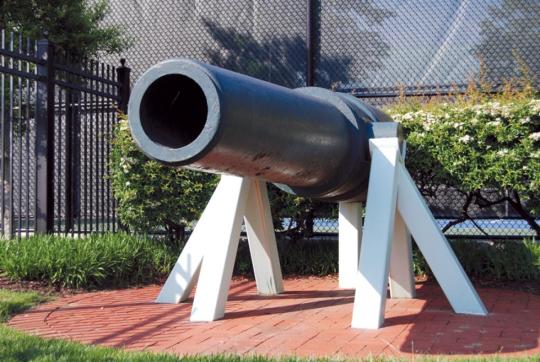
[The "Oregon" gun from the USS Princeton, now on display at the United States Naval Academy in Annapolis, Maryland.]
During World War II, a new USS Princeton was commissioned. A 622-foot-long aircraft carrier, the new Princeton engaged in action in the Pacific Ocean. On October 20, 1944 -- 100 years after the explosion of the "Peacemaker" during President Tyler's Potomac River cruise -- the modern Princeton was attacked by a Japanese dive bomber in the Leyte Gulf and 108 sailors were killed. Even the Princeton's descendants seem to be cursed.

#History#USS Princeton#USS Princeton Explosion#John Tyler#President Tyler#Tyler Administration#Julia Gardiner Tyler#David Gardiner#First Ladies#First Families#Presidential Marriages#Presidential Relationships#Robert Field Stockton#Abel Upshur#Politics#Political History#Military History#WWII#Dolley Madison#Thomas W. Gilmer#Tyler Family#Cabinet of John Tyler#Tyler Cabinet#Presidential History#Presidential Politics#Princeton Explosion#1844 Explosion of the Princeton#U.S. Navy#Naval Accidents#U.S. Naval History
21 notes
·
View notes
Text
🔥 Sat night after Shabbat - ISRAEL REALTIME - Connecting to Israel in Realtime
( 1 / 2 )
LAG SAMAYACH, a happy Lag b’Omer, the celebration of Rabbi Shimon bar Yochai and the mystical portion of the Torah.
▪️MERON RISK.. Security officials discussing the possibility of canceling even the tiny bonfires allowed at the Meron Tomb of Rashbi, due to direct threats of rocket and drone fire at the area.
▪️OBJECTION VIDEO IS FAKE.. on Friday a video was released supposedly from a reserve soldier in Gaza (with a mask on) saying the soldiers are sick of the situation having lost their jobs and homes and should consider rebelling against the IDF General and Defense Minister.
.. HOWEVER, the person who made the video was tracked down and arrested. NOT in Gaza, NOT in the army! The video was a fake, the trying to convince people to rebel orders - a crime. He has been arrested.
🔸DEAL, ROUND 33.. the negotiation talks are expected to resume next week in Doha, Qatar when delegations from Hamas and Israel will arrive to present their positions. The head of the Mossad presented to the mediators the guidelines approved by the cabinet, and agreed with the Prime Minister of Qatar and the head of the CIA to meet again.
.. Senior Hamas official Muhammad Mardawi clarifies: “The ball is in Israel's court regarding the end of the war. A permanent ceasefire is the only way to reach a deal. Any proposal presented to us must include a full Israeli withdrawal from the Gaza Strip.”
.. A senior Hamas official denied to Reuters the reports of renewed contacts in Cairo for a hostage deal.
▪️TUNNELS.. Israeli National Security Adviser Tzachi Hangabi: So far we have found 11 tunnels on the Philadelphia route between Egypt and Gaza, and we have no evidence if our kidnappers were taken out of Gaza. (( The Israeli Representative to the ICC said 50 tunnels. 50, or 11? Or??? ))
▪️A NOTE ON THE IMPOSSIBLE STANDARD OF THE COURT.. (( As many have noted, the court used as some of its reasoning that Israel is instructing Gaza civilians to move out of the combat zone. Moving civilians out of a combat zone is wrong, and keeping civilians in a combat zone is wrong. Per the court - if there are civilians, combat is illegal, if civilians are moved it is illegal. Defense is therefore illegal in enemy territory - regardless of whether they attacked you. ))
.. Leader ofIsrael Our Home party, MK Avigdor Lieberman: "As I warned, the decision of the Israeli government to appear before the International Court of Justice in The Hague was a serious mistake and falling into a trap with a predetermined end.”
🔥🔥Sat night after Shabbat - ISRAEL REALTIME - Connecting to Israel in Realtime
LAG SAMAYACH, a happy Lag b’Omer, the celebration of Rabbi Shimon bar Yochai and the mystical portion of the Torah.
( 2 / 2 )
▪️PIECE OF AID PIER BREAKS AWAY.. beaches in Ashdod, US landing craft sent to rescue it also beached in Ashdod. US says 4 pieces or vessels broke away due to weather, asking the Israeli Navy for help.
▪️US ATTACKS YEMEN.. Saudi Al-Hadath network: in an attack in Yemen yesterday by the US, two Iranians and about ten commanders and terrorists of the Houthis were killed. Among the Houthis who were killed were those who returned from a military college of the Iran Revolutionary Guards.
▪️PROTEST - HOSTAGES & ANTI GOVT. RALLY.. The Kaplan protest area / Begin gate in Tel Aviv, 100,000+ protestors for “deal now” and “govt. resign”. Chants - “The people do not forget Netanyahu the murderer.”
.. and is being broadcast LIVE on Al Jazeera.
⭕ ANTI-TANK MISSILES from Hezbollah at a house in Shatula, 2 houses in Metulla, and a synagogue in Dovev.
⭕ HEAVY ROCKET from Hezbollah HITS the Kiryat Shmona industrial zone. Significant damage.
⭕ ROCKETS FROM Hezbollah at Northern communities - 10 attacks over Shabbat. At least one was a barrage of 30+ rockets.
⭕ SUICIDE DRONES from Hezbollah at Northern communities - 6 attacks over Shabbat.
⭕ ROCKETS from Hamas at near-Gaza communities - 1 attack over Shabbat. 1
♦️JABALIYA - central Gaza.. A very big advance - the IDF controls most of the area - most of it is occupied and the rest is controlled by snipers. The next stage - capture of the west of the area. Rumors say that a commander of Hamas, Iz a Din Al Haddad, is hiding in the west area.
.. Captured and destroyed lathes for the production of rockets.
.. Arrests of men of fighting age for interrogation.
🔅 Sat night Lag b’Omer - ISRAEL REALTIME - Connecting to Israel in Realtime
🔥LAG SAMAYACH, a happy Lag b’Omer 🔥
⭕ EXPLOSION OVER MERON.. An explosion was heard over Miron, due to an interception.
▪️MERON LIMITED LIGHTING DELAYED.. due to the security situation (see item above) and the riot (see item below), permission and safety for a tiny lighting by the Boyaner Rebbe has not yet been approved.
▪️A FEW HUNDRED RELIGIOUS ZEALOTS.. violated the Home Front Command safety ban on entering the Tomb of Rashbi in Meron and rioted when ordered to leave by police - basically trashing the holy site in throwing things at the police. They were forcibly removed - putting both themselves and the security forces at life risk.
▪️TEL AVIV PROTESTS.. lit large fires in the road (NOT in honor of Lag b’Omer), at which point the police declared the protest illegal and called on demonstrators to disperse. The riot police, mounted police, and water cannon moving in after they refused to disperse.
▪️ON THE FAKE OBJECTION VIDEO.. (( Commentary by right-wing Channel 14 )) “For many months, the left side of the political map called for a mutiny in the army. They encouraged refusal and made it legitimate, and called to refuse an order to serve and refuse to obey the political echelon. Now that it comes from the right (a very wrong and serious thing!) those who did it until a few months ago in the name of 'democracy' are shocked and angry.”
🔸DEAL, HAMAS UPDATES.. Hamas: “Osama Hamdan, told the Al Jazeera network: We do not need new negotiations” (( because EU countries and the ICJ and ICC are doing their job for them. ))
▪️JEW UP FOR EXECUTION IN IRAN.. The request for a retrial of Ervin Nathaniel Kahrmani, a young Iranian Jew who was sentenced to "retribution" (execution) on the charge of "premeditated murder", was rejected by the Iran Supreme Court.
▪️POLICE / CHABAD CONFLICT IN LOD? Brief report that police are not allowing people to enter the Chabad neighborhood for a planned city Lag b’Omer event - with thousands crowding the police-closed entrance.
♦️COUNTER-TERROR - TULKARM (Samaria).. firefight between terrorists and the security services of the Palestinian Authority in Tulkarm, terrorist Muhammad Ahmed Khatib was killed.
♦️IDF ATTACKING IN CENTRAL RAFAH
♦️IDF WAVE OF ATTACKS - SOUTHERN LEBANON - The Air Force has launched another wave of attacks in southern Lebanon, and is now attacking the targets of Problema al-Sha'ab and Al-Hiyam
18 notes
·
View notes
Text
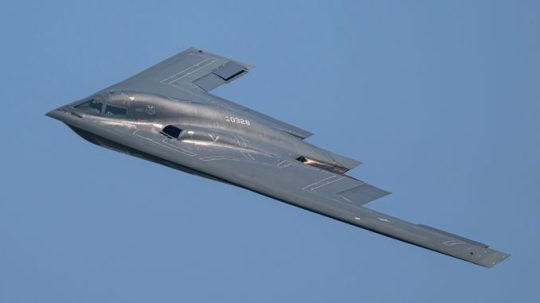
B-2 Stealth Bomber Demoes QUICKSINK Low Cost Maritime Strike Capability During RIMPAC 2024
The U.S. Air Force B-2 Spirit carried out a QUICKSINK demonstration during the second SINKEX (Sinking Exercise) of RIMPAC 2024. This marks the very first time a B-2 Spirit has been publicly reported to test this anti-ship capability.
David Cenciotti
B-2 QUICKSINK
File photo of a B-2 Spirit (Image credit: Howard German / The Aviationist)
RIMPAC 2024, the 29th in the series since 1971, sees the involvement of 29 nations, 40 surface ships, three submarines, 14 national land forces, over 150 aircraft, and 25,000 personnel. During the drills, two long-planned live-fire sinking exercises (SINKEXs) led to the sinking of two decommissioned ships: USS Dubuque (LPD 8), sunk on July 11, 2024; and the USS Tarawa (LHA 1), sunk on July 19. Both were sunk in waters 15,000 feet deep, located over 50 nautical miles off the northern coast of Kauai, Hawaii.
SINKEXs are training exercises in which decommissioned naval vessels are used as targets. These exercises allow participating forces to practice and demonstrate their capabilities in live-fire scenarios providing a unique and realistic training environment that cannot be replicated through simulations or other training methods.
RIMPAC 2024’s SINKEXs allowed units from Australia, Malaysia, the Netherlands, South Korea, and various U.S. military branches, including the Air Force, Army, and Navy, to enhance their skills and tactics as well as validate targeting, and live firing capabilities against surface ships at sea. They also helped improve the ability of partner nations to plan, communicate, and execute complex maritime operations, including precision and long-range strikes.
LRASM
During the sinking of the ex-Tarawa, a U.S. Navy F/A-18F Super Hornet deployed a Long-Range Anti-Ship Missile (LRASM). This advanced, stealthy cruise missile offers multi-service, multi-platform, and multi-mission capabilities for offensive anti-surface warfare and is currently deployed from U.S. Navy F/A-18 and U.S. Air Force B-1B aircraft.
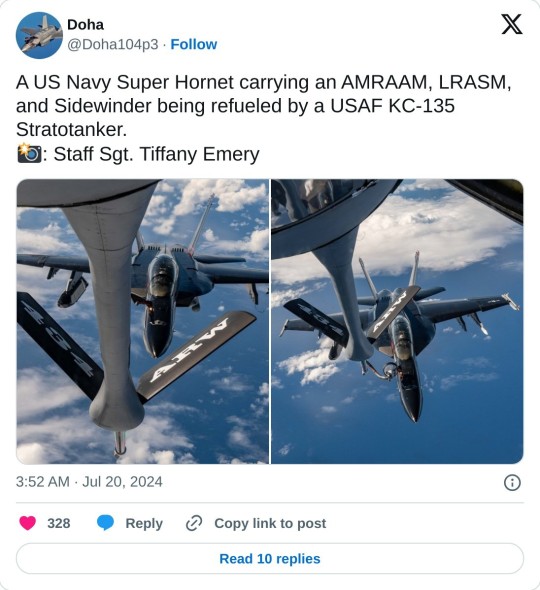
The AGM-158C LRASM, based on the AGM-158B Joint Air-to-Surface Standoff Missile – Extended Range (JASSM-ER), is the new low-observable anti-ship cruise missile developed by DARPA (Defense Advanced Research Projects Agency) for the U.S. Air Force and U.S. Navy. NAVAIR describes the weapon as a defined near-term solution for the Offensive Anti-Surface Warfare (OASuW) air-launch capability gap that will provide flexible, long-range, advanced, anti-surface capability against high-threat maritime targets.
QUICKSINK
Remarkably, in a collaborative effort with the U.S. Navy, a U.S. Air Force B-2 Spirit stealth bomber also took part in the second SINKEX, demonstrating a low-cost, air-delivered method for neutralizing surface vessels using the QUICKSINK. Funded by the Office of the Under Secretary of Defense for Research and Engineering, the QUICKSINK experiment aims to provide cost-effective solutions to quickly neutralize maritime threats over vast ocean areas, showcasing the flexibility of the joint force.
The Quicksink initiative, in collaboration with the U.S. Navy, is designed to offer innovative solutions for swiftly neutralizing stationary or moving maritime targets at a low cost, showcasing the adaptability of joint military operations for future combat scenarios. “Quicksink is distinctive as it brings new capabilities to both current and future Department of Defense weapon systems, offering combatant commanders and national leaders fresh methods to counter maritime threats,” explained Kirk Herzog, the program manager at the Air Force Research Laboratory (AFRL).
Traditionally, enemy ships are targeted using submarine-launched heavyweight torpedoes, which, while effective, come with high costs and limited deployment capabilities among naval assets. “Heavyweight torpedoes are efficient at sinking large ships but are expensive and deployed by a limited number of naval platforms,” stated Maj. Andrew Swanson, division chief of Advanced Programs at the 85th Test and Evaluation Squadron. “Quicksink provides a cost-effective and agile alternative that could be used by a majority of Air Force combat aircraft, thereby expanding the options available to combatant commanders and warfighters.”
Regarding weapon guidance, the QUICKSINK kit combines a GBU-31/B Joint Direct Attack Munition’s existing GPS-assisted inertial navigation system (INS) guidance in the tail with a new radar seeker installed on the nose combined with an IIR (Imaging Infra-Red) camera mounted in a fairing on the side. When released, the bomb uses the standard JDAM kit to glide to the target area and the seeker/camera to lock on the ship. Once lock on is achieved, the guidance system directs the bomb to detonate near the hull below the waterline.
Previous QUICKSINK demonstrations in 2021 and 2022 featured F-15E Strike Eagles deploying modified 2,000-pound GBU-31 JDAMs. This marks the very first time a B-2 Spirit has been publicly reported to test this anti-ship capability. Considering a B-2 can carry up to 16 GBU-31 JDAMs, this highlights the significant anti-surface firepower a single stealth bomber can bring to a maritime conflict scenario.
Quicksink
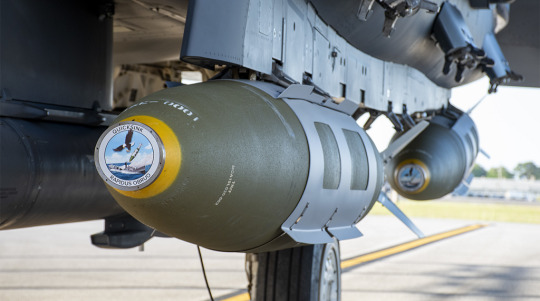
F-15E Strike Eagle at Eglin Air Force Base, Fla. with modified 2,000-pound GBU-31 Joint Direct Attack Munitions as part of the second test in the QUICKSINK Joint Capability Technology Demonstration on April 28, 2022. (U.S. Air Force photo / 1st Lt Lindsey Heflin)
SINKEXs
“Sinking exercises allow us to hone our skills, learn from one another, and gain real-world experience,” stated U.S. Navy Vice Adm. John Wade, the RIMPAC 2024 Combined Task Force Commander in a public statement. “These drills demonstrate our commitment to maintaining a safe and open Indo-Pacific region.”
Ships used in SINKEXs, known as hulks, are prepared in strict compliance with Environmental Protection Agency (EPA) regulations under a general permit the Navy holds pursuant to the Marine Protection, Research, and Sanctuaries Act. Each SINKEX requires the hulk to sink in water at least 6,000 feet deep and more than 50 nautical miles from land.
In line with EPA guidelines, before a SINKEX, the Navy thoroughly cleans the hulk, removing all materials that could harm the marine environment, including polychlorinated biphenyls (PCBs), petroleum, trash, and other hazardous materials. The cleaning process is documented and reported to the EPA before and after the SINKEX.
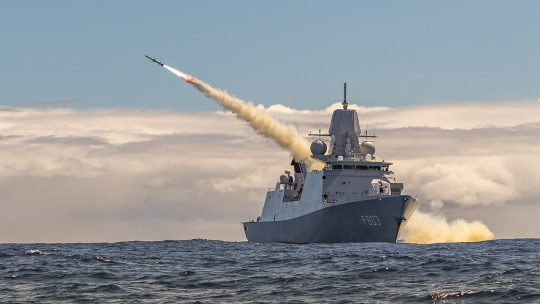
Royal Netherlands Navy De Zeven Provinciën-class frigate HNLMS Tromp (F803) fires a Harpoon missile during a long-planned live fire sinking exercise as part of Exercise Rim of the Pacific (RIMPAC) 2024. (Royal Netherlands Navy photo by Cristian Schrik)
SINKEXs are conducted only after the area is surveyed to ensure no people, marine vessels, aircraft, or marine species are present. These exercises comply with the National Environmental Policy Act and are executed following permits and authorizations under the Marine Mammal Protection Act, Endangered Species Act, and Marine Protection, Research, and Sanctuaries Act.
The ex-Dubuque, an Austin-class amphibious transport dock, was commissioned on September 1, 1967, and served in Vietnam, Operation Desert Shield, and other missions before being decommissioned in June 2011. The ex-Tarawa, the lead amphibious assault ship of its class, was commissioned on May 29, 1976, participated in numerous operations including Desert Shield and Iraqi Freedom, and was decommissioned in March 2009.
This year marks the second time a Tarawa-class ship has been used for a SINKEX, following the sinking of the ex-USS Belleau Wood (LHA 3) during RIMPAC 2006.
H/T Ryan Chan for the heads up!
About David Cenciotti
David Cenciotti is a journalist based in Rome, Italy. He is the Founder and Editor of “The Aviationist”, one of the world’s most famous and read military aviation blogs. Since 1996, he has written for major worldwide magazines, including Air Forces Monthly, Combat Aircraft, and many others, covering aviation, defense, war, industry, intelligence, crime and cyberwar. He has reported from the U.S., Europe, Australia and Syria, and flown several combat planes with different air forces. He is a former 2nd Lt. of the Italian Air Force, a private pilot and a graduate in Computer Engineering. He has written five books and contributed to many more ones.
@TheAviationist.com
12 notes
·
View notes
Text
1. The Raid
Sector -300 +145, +36 full rotations and 8 deci-rotations - ~287ly from Ka’Lagrath space
Ka’Laxi was standing on the bridge of the Eclipse. His ship was the flagship of the 1st raider fleet tasked with raiding the a system under the control of a small interstellar alliance.
The Ka’Lagrath didn’t have what could be considered a proper invasion fleet - their navy was comprised of several smaller raiding fleets. This was inline with standard naval doctrine of the time - fighting a massive war hundreds of light years away from your supply lines was seriously difficult. Thus, standard naval doctrine was extremely simple: Raid civilian or softer military targets, Take hostages, and extort the ever living hell out of the enemy civilization in exchange for the hostages. What few interstellar nations existed at the time all used similar tactics.
Ka’Laxi had many orbital “laps” worth of experience. He was considered to be the best of the best, he had effectively bullied several neighboring nations into giving up resources, territory, and even independence itself. Today would be no different, this small interstellar alliance was comprised of two neighboring species whose home worlds were only some 20 odd light years apart. This occurrence was considered extremely unlikely, as in most instances of this occurring in the past, only one nation had FTL capable craft - and habitable planets were desired enough as to make Xenocide the obvious choice.
Based on this information, the two species were thought to be pacifistic in nature. In other words: easy pickings. With this in mind Ka’Laxi was confident that the Alliance fleet - a fleet comprised largely of training vessels at that - would surrender almost immediately upon the beginning of the engagement.
“Exiting Rift-space now,” reported one of the officers.
“Very good,” Ka’Laxi replied. The haunting nebulae-like appearance of Rift-space was interrupted by a tunnel of streaking lights that gave way to real space as the Eclipse decelerated to sublight velocities. Before them was an average G-type star orbited by several planets. Orbiting the closest planet - about 51 light seconds away - was what was thought to be a military installation for training new naval crews. Why the alliance would put their training camp 72 light years from their home systems was unclear, but all that mattered was that the target would be soft.
The Ka’Lani drive reactivated, and by bending space around the ships, the fleet would make pace to arrive at the station in about 1 deci-rotation (~3hrs).
One Deci-rotation later, and the fleet was about to arrive. The destination lock activated, and the fleet was ‘dropped’ about 30km away from the station. An alliance ship immediately hailed the fleet. The Ka’Lagrath weren’t able to fully decode the language(s) used by the alliance, but they knew enough to “negotiate” with them. But unfortunately, of all the words used in the ship’s hail, the Ka’Lagrath only knew one: “business.”
“Begin attack,” Ka’Laxi ordered. The two pods either side of the bridge opened, revealing the end of the launching rail of their main rail gun armament. A deep, whirring noise built up for a moment before being released as the slugs from the two main guns fired towards the station. 5 seconds later, the left-hand wing of the station exploded violently - evidently they had hit the station’s fuel storage. The alliance ships seemed to get angry - they began hurling canon and plasma rounds in the direction of the fleet.
Had they not realized that plasma rounds are ineffective against most naval ships? Ka’Laxi wondered. In any case, while they weren’t initially expecting the Alliance to start fighting back, it wasn’t entirely unexpected either. All they had to do was destroy a few more ships and they would most likely surrender.
Interestingly, in the chaos, two Alliance ships immediately fled to Rift-space. Ka’Laxi was unsure if this was simply cowardice, or if they were attempting to get reinforcements. Whichever it was, it wouldn’t matter. Once they had hostages, no amount of ships would be enough to stop them.
The alliance ships got aggressive. One by one their comrades’ ships were forcibly and violently depressurized, and they had nothing to show for it - despite being outnumbered nearly 9 to 1, not one of the [species]’ 15 ships had so much as had their paint scratched. The alliance ships seemed to realize this, as scanners indicated that their plasma rounds were getting hotter - implying that the alliance ships were dumping more power into their weapons.
“Fools,” Ka’Laxi muttered, “when will they realize that they cannot so much as scratch us?” He let out a long sigh, “continue the attack.” One might almost feel bad for how poorly the Alliance was being beaten, yet they refused to give up. Ka’Laxi admired that tenacity, even if in the end it would be for naught.
“Sir?” An officer chimed.
“Yes?” Responded Ka’Laxi.
“Scans indicate that engine exhaust temperatures are rising on the alliance ships,” the officer reported.
“Are they attempting to flee?”
“N-no, they seem to be-“ the normally red face of the officer went blue as it drained of blood. As Ka’Laxi looked at the sensor array, his face, too, went blue.
“They’re… charging straight for us??” As if operated by a single mind, all 105 remaining alliance ships turned in unison towards the fleet and began to charge at them. The ship’s speed rose, three hundred, four hundred, even five hundred meters per second. At this rate, the Alliance ships would be on top of them in around 50 seconds.
“Intensify forward firepower!!” Ka’Laxi barked. The Alliance’s weapons were ineffective at range, but there was no guarantee that would remain the case in close-quarters combat. Ka’Laxi was baffled by the Alliance’s actions, getting in close to your opponent was suicide in a naval battle - by most standards, even 25-30km was way too close, and within 5km was considered suicide. But at present, the Alliance ships were eighteen, no, seventeen kilometers away - and they showed no signs of stopping.
At a distance of 5 kilometers, several Alliance ships broke off, and began a gentle dive away from the formation. The Alliance ships were not even firing their weapons at this point, they simply allowed the 1st raider fleet to score numerous hits and destroy multiple vessels without fighting back.
Before he realized it, the Alliance ships were swarming his fleet - flying by at hundreds of meters per second as they surrounded them on all sides. Ka’Laxi didn’t even have time to think before-
BANG
The entire ship shuddered. The hull squealed and screamed as if in agony while the lights repeatedly flickered.
“Report!” Ka’Laxi barked. His officers did not even have time to respond before another resounding bang shook the entire hull. He could hear the screeching noise of metal on metal, something on the Eclipse was being torn apart. The lights flickered one last time as the power died for good. All that remained were the red emergency lights, radio, and a rudimentary radar.
“N-Numerous Alliance ships have made contact with us, and the other ships are reporting the same,” one officer reported. They are ramming us? As Ka’Laxi recalled, ramming was used in the early days of Naval warfare on his home planet, but as technology advanced, ramming became an outdated tactic. Ramming in modern Naval battles - those set in the vacuum of space - were completely unheard of. Getting close enough to ram was suicide, yet the Alliance was doing just that.
“We’ve lost contact with the engine room!” Another officer reported, “the entire engine room seems to just be… gone,” he continued.
Ka’Laxi’s eyes widened as he saw one of the Alliance ships right in front of him - charging at full speed.
“Brace!” He yelled, but he was too late. The bridge let out a massive groan as it shuddered from the impact, and everyone in it was thrown to the ground. The reinforced glass windows were fractured, and several appeared to be leaking air. But Ka’Laxi was unconcerned with that at the moment. He, along with anyone else who was presently conscious, were all focused on the window in front of them.
He could see into the bridge of the Alliance ship. On it, he could see individuals from one of the two species that comprised the Alliance - those who called themselves “Humans” - running around frantically. They didn’t even evacuate?? Ka’Laxi was in shock. These things were reckless - they were monsters. Ka’Laxi was terrified of them.
The Alliance ships that had previously been maintaining contact with the Eclipse suddenly broke away. Ka’Laxi hadn’t the time to speculate as to why, before he heard the sound of screeching metal followed by rushing air before-
Silence
Ka’Laxi was disoriented, his body was tumbling freely in perfect silence. He tried to take in a breath, only to find he could not. Then he felt pain - one side of him was boiling, while the other was freezing. Blood vessels near the surface of his dark-red skin burst, spewing his red blood into countless tiny droplets.
Below him was a hunk of metal that had been split in half - one he barely recognized as the remains of his flagship, the Eclipse. Surrounding him on all sides was a perfectly dark sphere with innumerable pinpoints of light. He had been ejected from his now devastated craft, and he was tumbling endlessly in the vacuum of space.
His consciousness began to fade. But before it did, he saw one last sight - engines. The engines an Alliance ship expelling bright white exhaust. Unlike his own ship which had been utterly destroyed, the Alliance ship appeared to suffer little more than cosmetic damage.
They had lost. More than that, they could never win. If the Alliance so wished it, the Ka’Lagrath would go extinct - wiped off the face of the universe. They had been Naïve.
It was with these thoughts in mind that Ka’Laxi’s consciousness faded - never to rise again.
I hope you enjoyed this story. It’s my first time publishing something I’ve written so I’m nervous about posting it, but if even one of y’all enjoyed it, it’ll be worth it. I have more ideas set in this universe, so if people like it, I’d be willing to write more about what happens after this ill-fated raid.
I’ve been Rad, and thank you for reading :D
Read the next entry here
#humans are space orcs#humans are deathworlders#hfy#humanity fuck yeah#sci fi writing#my writing#scifi#reddit refugee#first writing
100 notes
·
View notes
Note
Do you think Alfred is insecure about being young? Like I know that there’s countries younger or closer to age to Alfred, but the people Alfred hangs out with the most, has more economic ties, and has military alliances with are way older than Alfred (ex literally all of Europe and Asia). So I was wondering if you think Alfred, being always around people with way more experience than him, feels insecure about being so young and ‘inexperienced’ maybe that’s why he wears glasseS
Interesting question! As I see it, yes and no.
Yes—in the 18th century, when he was much younger, and rebelling against Arthur. Going hat in hand to the other Old World empires and nations like Francis and Antonio for money was a pretty intimidating experience. So it was with Gilbert, coming to whip his ass into shape in Valley Forge. Even with other nations where he wasn't asking for major favours to fund his rebellion but more like 'hey recognise me? please? can my ships come to your ports?' like Morocco or Yao, during the Old China Trade (uhhhhh ive been banned from all the usual trading posts all across my father's empire...and I heard you guys like otter pelt and ginseng?).
No, because from the 19th century onwards, he's very much growing into a world power. I see Alfred as being quite a zealous idealist who sees potential for improving the world (not always in the best way, but from his POV it is), and this is the period where his mindset is increasingly one of brazen, youthful self-confidence. To him, his age is an asset. He's casting a pretty jaundiced eye on the Old World as a whole—perceiving them as being full of religious feuds, outdated monarchies and straitjacketed by nonsensical traditions: they’re ossified fucks who ought to realise the glory of republican civilisation and everything else he's got grand ideas about. Like, one contrast is really how much more intimidated I see him being going to China during the Old China Trade in the late 1700s—versus the brazen gunboat diplomacy of the Perry expedition to Japan in 1853. Like, the contrast with how the Americans behaved themselves when they had no navy and their ships were so small the Chinese traders thought they were tenders from larger vessels and not ocean going ships (lmao) and the Perry expedition is huge. 18th century Alfred would’ve been more intimidated around a nation who beheaded Kublai Khan’s emissaries and fought in more battles long before he was born—19th century Alfred isn’t.
And even less so in the 20th century—especially during WWII. There’s no victory unless he puts his thumb on the scale, and even Sir Lord Arthur Kirkland is openly begging for it. If people had any remaining thought of him as the young, ambitious crown prince somewhat walking in the shadow of his father, all that is gone in WWII. He steals the fire of the gods and literally makes it shine brighter than a thousand suns in all its terror and awe. Other nations can get under his skin, especially in the dynamics of a rivalry (Arthur, in their power struggle over influence, Kiku, as a duelling Pacific empire in the late 1800s—1945 and then also Ivan). But older Alfred is far less likely to be insecure solely on account of them being older than him. It’s more if he perceives they’re challenging his dominance and hegemony—or if they’re questioning his idealism and principles. Like Antonio at the end of the Spanish-American War—oh, you really are your father’s son. I can see moments of vulnerability where his youth and inexperience shines through (such as the American Civil War), but older Alfred’s insecurities tend to dig on faultlines regarding: challenges to his hegemony and principles because unlike Lord Father (tm), I think he’s far more of an idealist. He wants to be great and good, but greatness often is in direct conflict with the latter.
#hetalia#hetalia headcanons#hws america#alfred f jones#aph america#long post#i dont really do him with glasses mainly bc I see him as a pilot#during WWII and no lasik then#you'd have to have good vision
167 notes
·
View notes
Text
DUBAI, United Arab Emirates (AP) — Yemen's Houthi rebels likely fired an Iranian-made anti-ship cruise missile at a Norwegian-flagged tanker in the Red Sea in December, an assault that now provides a public, evidence-based link between the ongoing rebel campaign against shipping and Tehran, the U.S. military says.
A report by the U.S. Defense Intelligence Agency released Wednesday linked the attack on the Strinda, which set the vessel ablaze, to Tehran, the Houthi's main backer in Yemen's nearly decadelong war. The findings correspond with those of a Norway-based insurers group that also examined debris found on the Strinda.
It comes as the Houthis continue their monthslong campaign of attacks over the Israel-Hamas war, targeting ships in the Red Sea corridor, disrupting the $1 trillion flow of goods passing through it annually while also sparking the most intense combat the U.S. Navy has seen since World War II.
Iran's mission to the United Nations, responding to questions from The Associated Press, again denied arming the Houthis despite the reports.
“We are aware that (the Houthis) have significantly developed their military capabilities relying on their very own sources,” the mission said. "The prolonged war against them is the primary factor behind the expansion of their military prowess.”
The Strinda was coming from Malaysia and was bound for the Suez Canal and then on to Italy with a cargo of palm oil when it was struck by a missile Dec. 11. The attack sparked a major fire on board that the crew later extinguished without anyone being hurt.
Debris found on board later was analyzed by the U.S. military. The DIA compared the pieces of the engine from the missile found on board to the Iranian Noor anti-ship ballistic cruise missile.
“The Iranian Tolu-4 turbojet engine, used in the Noor (missile), has unique features — including the compressor stage and stator — that are consistent with engine debris recovered from the ... Houthi attack on the M/T Strinda,” the DIA report said. A stator is the stationary portion of an engine.
Those pieces match images of a Tolu-4 engine that Iran displayed at the International Air and Space Show in Russia in 2017, the DIA said. Visually, the engines bore similarities in the photographs.
The Noor was reverse engineered by Iran from the Chinese C-802 anti-ship missile, which Iran purchased from Beijing and began testing in 1996 before transfers stopped over a U.S. pressure campaign. The Iranian version is believed to have a range of up to 170 kilometers (105 miles), with an upgraded version called the Qader having a range up to 300 kilometers (185 miles). The Houthis have a look-alike missile to the Qader called the Al-Mandeb 2 with a similar range.
The Norwegian Shipowners’ Mutual War Risks Insurance Association, known by the acronym DNK, also examined the debris following the Strinda attack. The association assessed it was “highly likely” the vessel had been hit by a C-802 or Noor anti-ship cruise missile.
Before the Houthis swept into Yemen's capital, Sanaa, in 2014, the country did not have an arsenal of C-802 missiles. As the Saudi-led coalition entered Yemen’s conflict on behalf of its exiled government in 2015, the Houthis’ arsenal was increasingly targeted. Soon — and despite Yemen having no indigenous missile manufacturing infrastructure — newer missiles made their way into rebel hands.
Iran long has denied arming the Houthis, likely because of a yearslong United Nations arms embargo on the rebels. However, the U.S. and its allies have seized multiple arms shipments bound for the rebels in Mideast waters. Weapons experts as well have tied Houthi arms seized on the battlefield back to Iran.
While the U.S. has previously accused Iran of supplying the missiles the Houthis use in their attacks at sea, Wednesday's report provided photographic evidence for the first time. The report pointed to a seizure stemming from a Jan. 11 nighttime raid of an Iranian dhow traveling near the coast of Somalia, which saw two Navy SEALs killed. The Navy seized parts related to the Noor anti-ship cruise missile, the report said.
The Houthis have launched seaborne attacks since 2016, when they hit the Emirati vessel SWIFT-1 with a missile as it sailed back and forth in the Red Sea between an Emirati troop base in Eritrea and Yemen. They also tried to attack the USS Mason, an Arleigh Burke-class guided missile destroyer, around the same time.
But the Houthi attacks have rapidly escalated since November over the Israel-Hamas war in the Gaza Strip. The rebels have targeted more than 70 vessels by firing missiles and drones in their campaign that has killed four sailors. They have seized one vessel and sank two in the time since.
The Houthis maintain that their attacks target ships linked to Israel, the United States or Britain as part of the rebels’ support for the militant group Hamas in its war against Israel. However, many of the ships attacked have little or no connection to the war — including some bound for Iran, which backs the Houthis.
“The Houthis probably have used Iran-supplied weapons to conduct more than 100 attacks against land-based targets in Israel, Saudi Arabia, the United Arab Emirates, and Yemen and dozens of attacks targeting ships in the Red Sea and Gulf of Aden,” the DIA report said.
Meanwhile early Friday, the private security firm Ambrey reported that a ship traveling in the southern Red Sea saw what appeared to be a missile splash into the sea and another explode in the air nearby.
The U.S. military's Central Command meanwhile reported that it destroyed five Houthi drone boats and two airborne drones in the Red Sea, while destroying another drone in Houthi-controlled territory.
The Houthis did not immediately acknowledge either incident, though it said U.S.-led airstrikes had targeted the Hodeida region Thursday.
10 notes
·
View notes
Text
ODESA, Ukraine—In his office overlooking Odesa’s Pivdennyi Port on the Black Sea, Viktor Berestenko smiled contentedly at the half-dozen large international cargo ships just beyond the harbor. “It’s as beautiful as your first kiss,” said the grinning president of the Association of International Freight Forwarders of Ukraine. Speaking to Foreign Policy in late March Berestenko was only too happy to inform me that Ukraine’s three free ports—all in and around Odesa—are operating 24/7, and that the country’s grain exports are back to prewar levels.
The restoration of Black Sea trade is a major breakthrough for Ukraine, in stark contrast to the losses it has endured this year on the eastern fronts. In the Black Sea theater, Ukraine has pulled off the unthinkable: beating back the esteemed Russian Navy even though it has next to no naval force of its own.
From the tiny swath of coastline around Odesa, Ukraine has stymied Moscow’s attempt to landlock and hobble its economy by rendering it unable to market its voluminous agricultural exports. In the spring of 2022, the Russian military barricaded Ukraine’s Black Sea ports and brought exports to a standstill. This forced Ukraine to shift to land routes to market its goods and caused worldwide grain prices to spike, which raised concerns about famine in the Middle East and Africa. Today, Russia still occupies 16 Ukrainian ports. But the Black Sea front looks more hopeful for Ukraine than at any time since the war’s onset more than two years ago.
The Ukrainian fleet lost 80 percent of its vessels after the Russian occupation of Crimea in 2014. But, relying a combination of missile systems and unmanned drone boats guided by advanced GPS and cameras, Ukraine’s armed forces claim to have crippled a third of Russia’s Black Sea fleet. They have also upended the Russian supply lines that serve thousands of troops in the occupied areas of southern Ukraine.
On March 24, Ukraine landed another blow, reportedly using U.K.- or French-made air-to-surface missiles, taking out two large Russian landing ships and other infrastructure near the occupied Crimean port city of Sevastopol. Russia’s fleet has suffered such a drubbing that it prompted the firing of its top admiral, Nikolai Yevmenov, in mid-March. Today, Russia’s remaining ships are in docked in berths along the far side of the Crimean Peninsula, out of sight but not entirely out of Ukraine’s reach.
“Russia wanted to turn the Black Sea into a big Russian lake. But Ukraine reversed it,” said Volodymyr Dubovyk, the director of the Center for International Studies at the Odesa Mechnikov National University. “Russian ships today don’t venture into the northwest of the Black Sea.”
This cover has enabled Ukraine to improvise a sea corridor that begins in Odesa and hugs the safe shores of NATO members Romania, Bulgaria, and Turkey as ships travel southwest en route to the Bosphorus Strait, through which most Black Sea trade passes. Exploiting a bumper crop, Ukraine is now exporting as much grain—corn, wheat, and barley—as it did before the war, as well as other goods, and has opened its Odesan ports for nighttime business to handle yet more. Prior to the war, Ukraine traded more grain than the entire European Union and supplied half of the globally traded sunflower oil, as well as iron ore and fertilizer, according to Bloomberg.
“This is enormously important for Ukraine’s economy, for the Odesa region, and for our future,” said Sergey Yakubovskiy, an economist at Odesa National University. “We have to do everything to keep this route open and reliable.”
Ukraine’s asymmetric Black Sea strategy relies ever more upon Ukraine-made drone boats—known as uncrewed surface vessels (USVs)—that speed across the water beneath Russian radar carrying up to 800 kilograms (1,760 pounds) of explosives. These projectiles have sunk or disabled some of the 24 lost Russian warships, evidence that Ukraine’s domestic arms production has been stepped up and is increasingly consequential in the absence of anticipated U.S. and European assistance. According to the Guardian, there are currently 200 drone manufacturing companies in Ukraine, some of them bankrolled by crowdfunding campaigns. In December 2023, they delivered 50 times as many robotic explosives as in the entire year of 2022, according to Ukraine’s Ministry of Digital Transformation.
Ukraine’s strategy is to maintain its presence in the Black Sea with the prospect of soon acquiring the longer-range missiles that it needs to hit Crimea itself and Russia proper beyond it, Dubovyk said. For Ukraine, he explained, the pressing issue is what comes next. “Crimea is in play, and if Ukraine can put more pressure on Russia there, it can make the occupation untenable. It would change the war’s logic if Russia couldn’t supply the eastern fronts from Crimea,” he said.
Russia’s response has been to target Odesa’s ports, energy infrastructure, and housing blocks with ballistic missiles. Seldom does a day pass without air raid sirens in the port city, which send its residents scrambling into their cellars. In March alone, Russian attacks killed 32 civilians.
One would think that the new coastal sea route would obviate Ukraine’s need to access EU markets via land, namely through Central Europe, and thus ameliorate the friction it has caused between the Central Europeans and Ukraine. Following Russia’s invasion, the EU allowed Ukraine tariff-free access to its markets, which had the effect of undermining the Visegrad Group states’ own grain trade and prompting farmers to take to the streets in anger, above all in Poland. Now, logically, trade could revert to its previous routes and the injurious tiff come to an end.
Not so quickly, explained Yakubovskiy, the economist. He pointed out that Ukraine’s new sea corridor is a temporary and unsanctioned byway, possible now only as a result of Russia’s naval weakness and an informal agreement between Russia and Ukraine not to target civilian shipping. It could end at any moment, he said.
As for Russia, it is not likely to improve its Black Sea positions soon. This is because Turkey controls the Bosphorus and Dardanelles straits, and Ankara has chosen to adhere to the letter of the 1936 Montreux Convention, which prohibits the passage of warships through the straights into the Black Sea in a time of war. Russia thus has no way of getting reinforcements to its ports.
The upshot of Russia’s retreat from Black Sea waters and Turkey’s control of the straits has put Ankara in the driver’s seat. Whether Ukraine maintains its new trade route thus depends, to some extent, on Turkey.
In the past, Ankara has shown itself deft at using leverage to promote its own interests, whatever they may be. It could turn Viktor Berestenko’s bliss into a short-lived fling.
12 notes
·
View notes
Text

Bruh imagine a One Piece had a version of Santa that turns Bad Kids into Presents for the Good Kids. Although in truth Santa has been working as a slave by the Navy in order to quelm rioting and uprising among the rising Pirate Nations as the Straw Hat Pirates Sail towards finding the One Piece while saving towns and islands from corruption of the Evils in this world's Government's Agenda. In secret the Navy kidnapped and is holding Mrs. Clause and their 9001 Elves as leverage over Santa as they force fed him the Conversari-Conversari Fruit because Santa doesn't like Cold Fruits he loves Hot Fresh Cookies The only way to lure him out is a plate of cookies cooked in a forest Fire the size of Pompeii and a cold glass of Milk as tall as the Eiffel Tower that was chilled in the Artic Sea. After defeating Santa Luffy and his Crew discover Santa was used by the Navy so they set sail to the north Artic to rescue the Jingle Nation's Citizens where they find The Man behind it all an Admiral Called Grinch Sourmilk. He has The Power of the Wrap-Wrap fruit and his power to encase in anything he touches slowly overtime with Enhanced Haki Tape and Prism Stone Lined Navy themed wrapping paper. The reason he volunteered to overwatch the The Jingle Nation was because he always hated Christmas because 27 years ago one cold Christmas morning he had nothing to eat but snow and salt and never had presents until one day he was recruited by a Navy Officer to work as a Janitor on his ship after the Crew had recently got attacked at sea by sea monster fish half of the crew quit or had never survived the journey. He was told by the Navy Official if he ever wanted to leave his impoverished lifestyle and to be able to never look back again he must leave this small port town at the break of dawn tomorrow. 17 year old Grinch had felt like after hitting rock bottom he's finally moving up in the world and sneaked upon the vessel at sunset the very same day and even stole a uniform from one of the fallen recruits that perished at sea and in the right hand pocket was a small fruit unbeknownst to Grinch that it was a devil fruit as his stomach growled violently as his fingers traced the outer skin of the plumpy red fruit and chomped on it without a second thought to who could be watching him grave robbing. Unfortunately due to the power of the Wrap-Wrap fruit any presents Grinch gets for his Birthdays or Christmases ends up getting wrapped again along with the person giving him the gift. A miserable experience for Grinch as he never has been able to open any gift he's ever received also the person that gave Grinch the gift is also to be wrapped in the Stone Prism Lined Paper alive leaving them to suffocate and die. The families of these victims are horrified each and every year their kin are returned to them and left at the front doorstep as a deceased Bow Wrapped Navy themed corpse with the paper slightly damp with tears of fear and pain. Grinch doesn't have any enemies or at least not for very long because he fights dirty always going for the weak first and attacks members of the victim's family without warning. No one is brave enough to stand against him. His peers revere him as a god because he keeps an iron fist in shutting down pirate crews before they even make headlines on the local town newspapers but Grinch hates them because he hates being stared at when in public because he gets this weird feeling he's gonna be asked something but they never say a word and just stand and stare making things awkward as it wastes his precious spare time. He enjoys anything he can drink through a straw and hates anything he has to touch with his hand to eat because he ends up just magically wrapping it in paper instead unable to control his powers. He wears regular wool gloves and sunglasses even when he sleeps!
#one piece#Santa#Christmas#fanfic#story#straw hat pirates#luffy#elves#pompeii#eiffel tower#artic#jingle#presents#cookies
17 notes
·
View notes
Text
Explosion of a ship, implosion of a life
By Jonathan Monfiletto
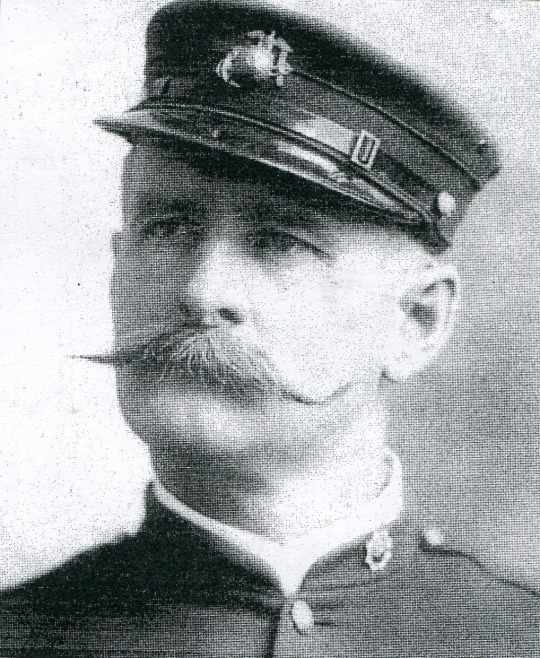
Marine Corps Sgt. Maj. William Anthony wasn’t born in Yates County, and he isn’t buried here either. It seems the only time he set foot on Yates County soil was for a month-long stint picking grapes in Jerusalem in the fall of 1899; his wife was from Guyanoga, and his son settled in the Dresden area as an adult. Otherwise, Sgt. Anthony had no connections here.
However, the memory of Sgt. Maj. Anthony and the story of his heroic deed continue to live on in Yates County – whether modern-day residents realize it – in the name of a road bearing his surname. Anthony Road, which runs from Route 14 southward into the village of Dresden, honors the man who played the role of a tragic hero in the story of the Spanish American War.
While recent findings suggest the explosion aboard the USS Maine was caused by a spontaneous fire in the coal bunker, in 1898 fingers pointed toward the ship being blown up by a mine set by Spanish forces. What isn’t under dispute is, first, that the incident led directly to the Spanish American War and, second, that it was then-Pvt. Bill Anthony who sounded the alarm to the ship’s commander about the explosion.
According to an article in the Penn Yan Democrat of February 17, 1933, Anthony was acting as orderly to Navy Cpt. Charles Sigsbee, the Maine’s commander, on February 15, 1898. The ship was anchored in the harbor of Havana, Cuba, “and all was peaceful when the deafening, rending blast rocked the vessel,” the newspaper stated, at approximately 9:40 p.m. Eastern time.
According to historian John Creamer, it was an oppressively warm and humid evening. The Maine had been sent to Cuba on a goodwill visit to protect American citizens and interests on the island nation, while tensions between the United States and Spain – which controlled Cuba at the time – reached a boiling point after building up for years. The Maine’s presence was meant to encourage Americans and Cubans and challenge the Spanish.
Creamer described Anthony’s experience that evening this way: “Private Bill took a long stroll on deck to postpone retiring to his steaming hammock below. There was no air conditioning then – in fact, the Maine was the first US Navy vessel to have electric lights. It was just as well for Bill that he dawdled, for at exactly 9:40 p.m. he and a number of others, on board the Maine and elsewhere around the harbor, saw a sheet of orange flame envelop the bow of the battleship. The explosion that followed was so tremendous that an eyewitness on another ship said that the Maine was lifted nearly out of the water by its force. … In the aftermath of the explosion, Private Bill realized that he had to get a message to Captain Sigsbee. He ran to the captain’s cabin in the dark. … The captain, not unaware that something had happened to the ship (he said later that he thought they were being fired upon by nearby Spanish guns), emerged from his cabin just as Private Bill arrived. In the darkness, the two men collided. … Private Bill backed off, apologized, saluted, and spoke the words that would put him into the history books.”
Those words, according to the Democrat, were: “I have the honor, sir, to report the Maine has been blown up and is sinking.” Sigsbee commended Anthony’s action in the captain’s record of the event, as transcribed in the Democrat: “The special feature in the case of this service performed by Private Anthony is that on an occasion when man’s instinct would lead him to seek safety outside the ship, he started into the superstructure and toward the cabin, irrespective of the danger. The action was a noble one and I feel it an honor to call his conduct to the attention of the recommendator that he be made a sergeant.”
Indeed, Anthony was promoted to sergeant and then, rather quickly, to sergeant major. According to Creamer, Anthony – 44 years old at the time – had served in the Marine Corps for 28 years. It is unclear what he did in the military prior to February 1898 – his service predates the Civil War – and why he remained a private for 28 years. Creamer notes promotions came slowly in those days – but apparently rapidly in the face of heroic acts – and there wasn’t much opportunity for a private to distinguish himself.
The disaster aboard the Maine killed 260 of the 328 crew members; indeed, only 16 were left uninjured. Though Anthony was listed among these 16, he received splinters in his face and through his hand when a lifeboat disintegrated in the explosion. He managed to climb into one of the remaining boats and row about the ship – in a hail of shrapnel and exploding ammunition – to look for survivors.
With no ship to serve on, Anthony subsequently was transferred to guard duty at the Brooklyn Navy Yard and given the highest enlisted rank in the Marine Corps. Anthony retired from the Marine Corps shortly after, in June 1898. Entitled to retirement pay after nearly 30 years of military service, Anthony – out of what the Democrat described as “character modesty” and fear “that the application might reflect on his superior officer who had helped him to get his rapid promotion,” Anthony declined the benefit and left the Marine Corps with no job and nothing but his name and reputation as a national hero.
Someone was looking to cash in on Anthony’s 15 minutes of fame, however, and a group of promoters convinced the Marine to take part in a play about the recently concluded Spanish American War, titled “The Red, White, and Blue.” Anthony’s role consisted of his appearing on stage in his Marine Corps uniform and reciting, “Remember the Maine!” to thunderous applause from the audience. However, the production closed quickly, as people were not ready to view a reenactment of a war they had just witnessed.
So, Anthony was once again out of work. In the interim, he got married to Adella Blancet, of Guyanoga, in October 1898. Adella had written to the national hero to seek his autograph; though he had received many such letters, for some reason Adella’s letter stood out and he wrote back to her. They soon wed and then had a son, William Jr., born in July 1898.
Following the grape harvest in the fall of 1899, Anthony left Adella and William Jr. in Guyanoga and traveled back to New York City to try to find work. He wasn’t willing to pull strings with his reputation and mention his struggle, and he lacked marketable skills outside of his military service.
On November 24, 1899, Anthony was sitting on a bench in Central Park when two police officers noticed him acting strangely with agitated behavior but also recognized who he was. Suddenly, Anthony pulled a small glass bottle out of his pocket and swallowed the contents. The officers attempted to help him, but he told them he didn’t want to be saved. Sure enough, Anthony died within an hour from an overdose of cocaine extract.
While the national hero was mourned following his shocking death, his name and reputation were quickly forgotten. Adella stayed in Yates County, and William Jr. grew up there. The son of the national hero married, became a successful farmer and vineyardist, served as Torrey town supervisor, and lived on the road that bears his family name.
In December 1942, the Navy remembered Anthony by launching the USS Anthony, a destroyer named in honor of the hero from the Maine. William Jr.’s daughters – Alice, a freshman at Keuka College, and Frances, a student at Penn Yan Academy – christened the ship bearing their grandfather’s name. In World War II, the destroyer saw action against the Japanese in the Philippines.
Interestingly, while William Jr. is buried in Evergreen Cemetery in Dresden – not too far from where Anthony Road enters the village – Anthony is buried in The Evergreens Cemetery in Brooklyn. Yates County continues to remember this non-resident who became a national hero.


#historyblog#history#museum#archives#american history#us history#local history#newyork#yatescounty#torreyny#dresdenny#jerusalemny#guyanogany#spain#cuba#ussmaine#spanishamericanwar#ussanthony#destroyer#ship
3 notes
·
View notes
Text
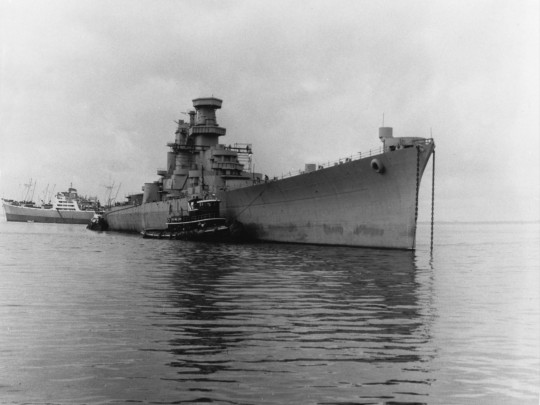
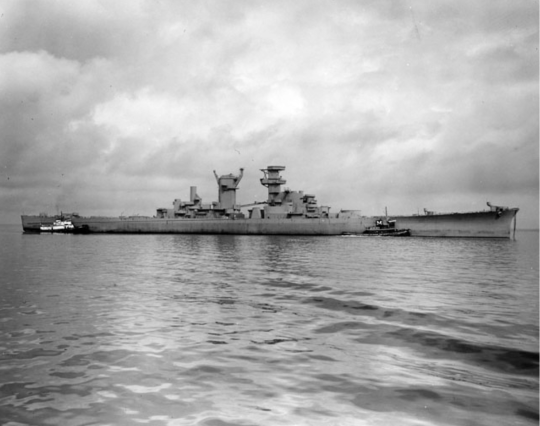
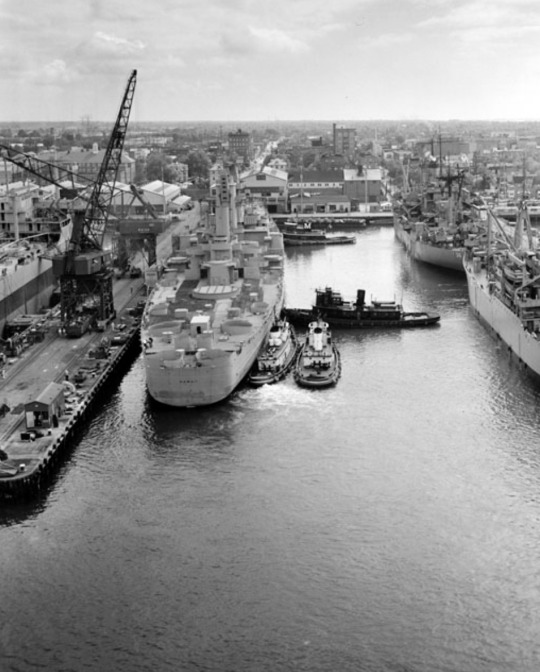
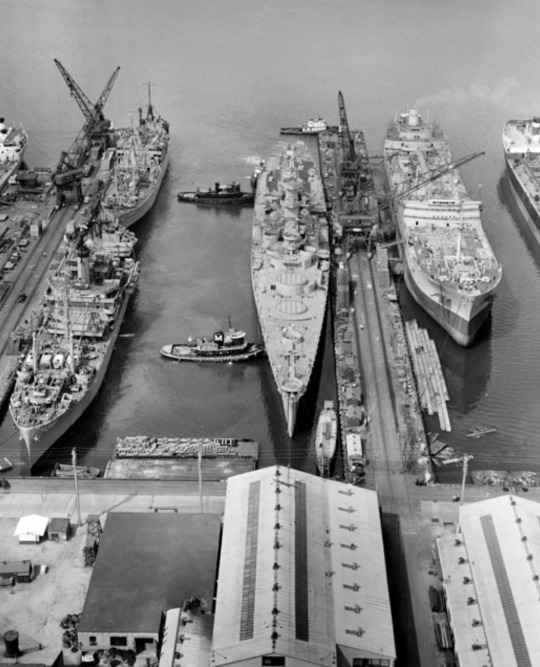
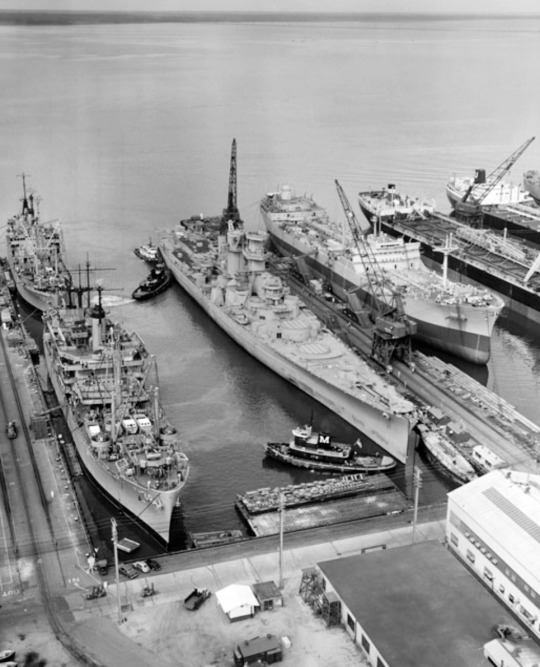

The incomplete HAWAII (CB-3) being moved to a berth, likely on her way to the scrapyard. Photographed on either May 20 or June 20, 1959. Likely the latter since the Navy Heritage and History Center has a better track record with dates.
Note: her 12 inch/50 caliber Mark 8 gun turrets have already been removed. They were removed in preparation for Hawaii would have become an Aircraft Carrier Task Force Command Ship, under SCB-83 and her hull designation changed to (CBC-1). Unlike the proposed ballistic and guided missile conversions, this conversion was budgeted in 1952.

Painting by Wayne Scarpaci
"This was as parallel to this program was a project to convert the unfinished Oregon City class heavy cruiser NORTHAMPTON (CLC-1) (later CC-1, ex-CA-125) to a National Emergency Command Post Afloat (NECPA). The NECPA program command ship (NORTHAMPTON) was where the US President and his Staff would direct US Military Forces during a nuclear conflict."
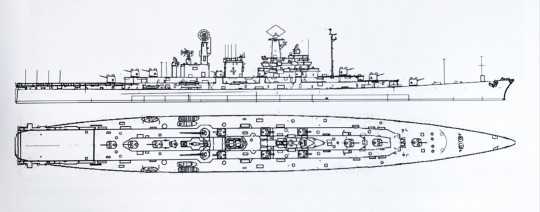
"Command and control of USN carrier forces during WWII was generally conducted from a standard vessel of the Task Force, with either a battleship or a carrier usually designated as flagship. But the presence of the force commander and his staff aboard was disruptive and resulted in overcrowded conditions, which impacted the combat effectiveness of the assigned ship. But with the superiority of the dedicated Amphibious Command Ship (AGC) concept for command and control of assault forces repeatedly demonstrated during WWII. Serious postwar consideration was given to the concept of a similar dedicated type of ship for Command and Control of Carrier Task Forces. In keeping with this concept in 1952 the USN developed the SCB-83 project to convert the HAWAII into a dedicated Carrier Task Force Command Cruiser (CBC-1). This design was strictly intended as a single mission ship featuring extensive flag facilities for command and control of carrier task forces, but no accommodations for amphibious or other types of operations.
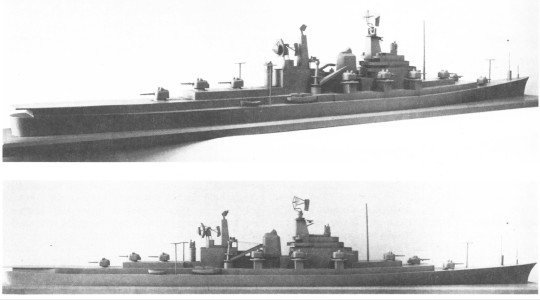
The ship would have been armed with six 5 inch/54 caliber guns in single mounts, shipped three forward and three aft, with eight 3 inch/70 caliber guns in four enclosed twin mounts amidships. It would have fitted an AN/SPS2 radar atop a forward tower and an AN/SPS8A height finder on the aft superstructure. There was to be an SK-2 parabolic dish for tropospherical backscatter communications mounted atop short tower aft of the stack, forward of the AN/SPS8A. Two Mk37/directors with Mk25 fire control radars were provided on the superstructure fore and aft. The superstructure was built up amidships to accommodate the flag staff facilities and the single stack of the original CB design retained."
Work was halted after the turrets were removed and would continue after experience was gained from the conversion of NORTHAMPTON. However, it was discovered that it was easier and cheaper to convert USS WRIGHT (CVL-49) into the second Command ship without the loss of capability and HAWAII was sent back to the reserve fleet in Philadelphia Navy Yard.
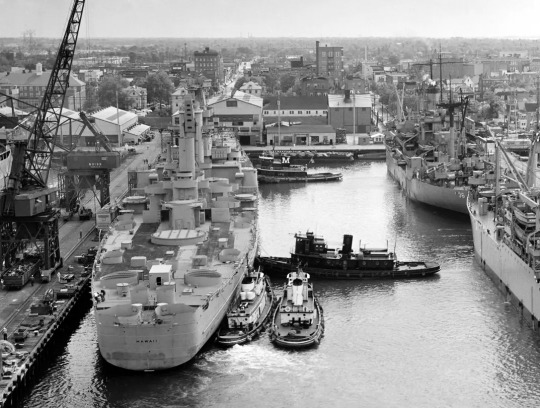
The hull remained in the reserve fleet for 12 years before it was finally scrapped along with the incomplete hulls of KENTUCKY (BB-66) and ILLINOIS (BB-65).
U.S. Naval History and Heritage Command: NH 89293
Mariner's Museum and Park: P0001.014/01-#PN4850, P0001.014/01-#PN4858, P0001.014/01-#PN4853, P0001.014/01-#PN4847, P0001.014/01-#PN4848, P0001.014/01-#PN4849
Information, diagram and painting from "USN BATTESHIP CONVERSIONS PROJECTS" by Wayne Scarpaci: link
source
#USS HAWAII (CB-3)#USS HAWAII#Alaska Class#Large Cruiser#Battlecruiser#Cruiser#Warship#Ship#United States Navy#U.S. Navy#US Navy#USN#Navy#USS HAWAII (CBC-1)#Aircraft Carrier Task Force Command Ship#Command Ship#SCB-83#Cancelled#Philadelphia Navy Yard#Philadelphia#Pennsylvania#East Coast#Delaware River#scrapped#reserve#reserve fleet#May#June#1959#my post
48 notes
·
View notes
Text
Thursday, October 3, 2024
Helene death toll now at least 166 (AP) President Joe Biden will survey the devastation in North and South Carolina on Wednesday as rescuers continue their search for anyone still unaccounted for after Hurricane Helene caused catastrophic damage across the Southeast and killed at least 166 people. Many residents in both states were still without running water, cellular service and electricity as floodwaters receded and revealed more of the death and destruction left in Helene’s path. Helene, one of the deadliest storms in recent U.S. history, knocked out power and cellular service for millions. More than 1.2 million customers still were in the dark early Wednesday in the Carolinas and Georgia. Some residents cooked food on charcoal grills or hiked to high ground in the hopes of finding a signal to let loved ones know they are alive.
Russian fighter jet flew within feet of US F-16 near Alaska (AP) On Monday, Pentagon officials released footage of a Russian fighter jet flying dangerously close to a U.S. F-16 jet. The footage, according to the Pentagon, was recorded on September 23 in U.S. airspace over Alaska. The game of giant metal aerial chicken took place just a few weeks after the Russian and Chinese militaries conducted joint drills in the Arctic near Alaska. Those drills involved multiple fighter planes and bombers from both militaries, as well as fleets of their navy vessels.
As Israel escalates in Lebanon, U.S. influence is limited (Washington Post) First Israel ignored a U.S.-led effort to impose a cease-fire in its escalating war against Hezbollah. Then it killed the militant movement’s leader, Hasan Nasrallah, in a massive attack, taking Washington by surprise. Now, following a weekend scramble to avert a ground invasion of Lebanon, Israel is conducting exactly that, underscoring Prime Minister Benjamin Netanyahu’s disregard for the Biden administration’s entreaties and the limits of its influence on his actions. The widening gap between U.S. desires and Israeli behavior has left the administration struggling to adapt its diplomatic efforts to accommodate Netanyahu’s impulses. This chasm between the two allies has become especially pronounced in the days since the White House promised on Wednesday that Israel and Lebanon were about to agree to a cease-fire deal, only to end up a bystander as Netanyahu vowed at the United Nations to wipe out Hezbollah’s ability to threaten Israel for the foreseeable future. With many U.S. officials now embracing Israel’s success as it proceeds, with stunning momentum, to degrade Hezbollah, the events of recent weeks appear to fit a pattern in which the administration urges against specific Israeli actions only to later backtrack so it can avoid imposing conditions on military aid.
Argentine town battles a parrot invasion (Reuters) The town of Hilario Ascasubi near Argentina’s eastern Atlantic coast has a parrot problem. Thousands of the green-yellow-red birds have invaded, driven by deforestation in the surrounding hills, according to biologists. They bite on the town’s electric cables, causing outages, and are driving residents around the bend with their incessant screeching and deposits everywhere of parrot poo. “The hillsides are disappearing, and this is causing them to come closer to the cities to find food, shelter and water,” biologist Daiana Lera said, explaining that much of Argentina’s forest land has been gradually lost over the years. At times, according to locals, there are up to 10 parrots for each of the town’s 5,000 human inhabitants. During the summer, the birds migrate south to the cliffs of Patagonia for the breeding season. Images show hundreds of birds perched along electric cables and on pylons, or silhouetted in the dusk light swarming over buildings and a church, eerily reminiscent of scenes in film director Alfred Hitchcock’s classic 1963 thriller “The Birds.”
Italy and Switzerland to redraw Alpine border due to melting glaciers (Washington Post) Italy and Switzerland are set to redraw part of the mountainous border separating the two countries due to melting glaciers in the Alps. The change, which impacts an approximately 330-foot-long segment of the border, is happening near one of Europe’s most popular skiing destinations, Zermatt, and the iconic Matterhorn mountain. One of the biggest glaciers near Matterhorn, the Theodul Glacier, retreated almost 1,000 feet between 1990 to 2015. The melting, which has been attributed to climate change, revealed new topographical details that raised new questions about the dimensions of the border between the two countries. In 2022, the jurisdiction of a glacial Italian mountain lodge there came under question when melting ice revealed the refuge was actually straddling the border.
Ukraine’s east buckling under improved Russian tactics, superior firepower (Washington Post) Soldiers from Ukrainian units along the front have described improved Russian tactics this summer that combine their advantages into powerful attacks that Ukrainians have struggled to counteract. Enemy troops are storming the battlefields in small teams that minimize detection and make return fire difficult, backed by superior quantities of artillery and drones. Russia has also improved its battlefield communication, helping coordinate attacks. While losses are staggering, Ukrainian soldiers have said, the Russians have the numbers to keep up the pressure and Western aid isn’t making up the equipment deficit. That confluence of factors, combined with Ukraine’s perennial challenge to replenish its combat units and its focus on a large operation inside Russia, has allowed Moscow’s forces to claim territory in the Donetsk region with speed and aggression not seen since the full invasion in 2022. Ukrainian forces have been retreating along dozens of miles of a front line being pushed to its breaking point.
A US bomb from World War II explodes at a Japanese airport (Foreign Policy) What is believed to have been a World War II-era bombshell detonated near a regional airport in southwestern Japan on Wednesday, nearly 80 years after the war ended. The Japan Ground Self-Defense Force stated that the explosive appeared to be a 500-pound U.S. bomb that was likely dropped in an effort to stop Japanese “kamikaze” attacks, as the airport used to be a Japanese navy base from which hundreds of kamikaze pilots took off on their final missions. No injuries were reported in the explosion but nearly 90 flights were canceled, as Miyazaki Airport now must determine how to fix the 23-foot-wide and nearly 3-foot-deep crater in the middle of its taxiway.
Typhoon bringing heavy rain heads toward Taiwan (AP) A typhoon bringing strong winds and torrential rainfall slowly advanced Wednesday toward Taiwan, where thousands of people have been evacuated from vulnerable low-lying or mountainous terrain. At least 93 centimeters (3 feet) of rain has fallen in the coastal Taitung County in the past four days and 29 centimeters (11.4 inches) in the major port city of Kaohsiung ahead of Typhoon Krathon. The typhoon, packing maximum sustained winds near the center of 173 kph (108 mph) and gusts of 209 kph (130 mph), is expected to make landfall early Thursday. Schools and offices have been closed, flights and ferry services canceled and the city mayor has asked the 2.7 million residents to stay indoors. Around 10,000 people have been evacuated from at-risk areas.
Israeli strikes on Lebanon are the most intense and deadly in decades (Washington Post) For 10 days, Israel unleashed a relentless air campaign on Lebanon, striking over 3,600 Hezbollah-linked targets ahead of a ground offensive, according to IDF statements. “Aside from Gaza, this is the most intense aerial campaign that we know of in the last twenty years,” said Emily Tripp, director of Airwars, a British conflict monitor. The strikes have leveled entire residential blocks in south Beirut and devastated Hezbollah’s upper ranks, killing its leader Hasan Nasrallah and political deputy Nabil Kaouk. At least 1,400 people have been killed and 900,000 displaced since Israel accelerated its cross-border campaign (a fifth of the population), according to the Lebanese government. Fifty children died under Israeli bombardment on Monday and Tuesday—the United Nations estimates that’s double the rate of children killed during Lebanon’s 2006 war.
We risk dying from the cold, says displaced man in Beirut (BBC) The Lebanese prime minister said yesterday around a million people have been displaced as Israel's air strikes continue across Lebanon. With emergency shelters in Beirut unable to accommodate all those arriving from the south, many are sleeping by the road, in public squares, or on the beach. "We were forced to leave our villages and homes and come to Beirut, but there are no available houses or schools, all are overcrowded," a man tell our colleagues on BBC Arabic. "If we survive the bombings, we risk dying from the cold weather and diseases. We can't afford medicine should we fall ill. Many suffer on the streets," he adds. Another man says he now lives on the street and does not know what to do: "We left everything behind and arrived here with no clothes or resources." "Apartment rents have skyrocketed beyond our means, leaving us on the streets with our children in the cold winter," another person says. "We are enduring a truly tragic situation.”
As Crisis Builds, Lebanon’s Government Is Nowhere to Be Found (NYT) Even for the Lebanese, it can be hard to say where it all went wrong for their tiny, beautiful country. Certainly it was long before early Tuesday morning, when Israeli troops marched into southern Lebanon. Long before Friday, when Israel assassinated Hassan Nasrallah, the revered and reviled Hezbollah leader who had a chokehold on the country’s politics and security for years. And long before last October, when Hezbollah and Israel began trading airstrikes and rocket fire across the border, bringing the war in Gaza to Lebanon’s green, fertile south. Many say Lebanon’s current anguish began in 2019, when the economy imploded and took the country’s once-robust middle class with it. Mass anti-government protests that fall did nothing to dislodge the country’s widely loathed political class. Others might mention 2020, the year the coronavirus further crippled the economy, and the year an enormous explosion at Beirut’s port shattered entire neighborhoods of the capital. A good case could be made for going all the way back to the 15-year civil war that ended in 1990. All these crises and more have left Lebanon in no shape to withstand a sharply escalating conflict with Israel, like a 10-car pileup caught in the path of a tornado.
A man in south Lebanon cares for pets left behind as residents flee Israeli strikes (AP) A dog clings to Hussein Hamza inside a car as he pans his camera around to show the aftermath of an Israeli airstrike in southern Lebanon. “Poor thing. Look at this, he’s clinging to me out of fear,” Hamza says in the video he posted online. “A missile hit here,” he said, his voice shaking. As Israel pummels southern Lebanon with airstrikes, tens of thousands of residents are fleeing their homes in fear. But Hamza is staying. His mission is to care for the dogs and other animals left behind. He runs an animal shelter that houses 200 dogs in the village of Kfour. Recently, he has also been driving around towns and villages in the south, looking for stray animals and abandoned pets to feed. “I opened bags of food and left them water. I’m relying on God,” said Hamza.
Nigeria’s independence anniversary is marked by protests and frustration over economic hardship (AP) Nigerians on Tuesday staged protests against economic hardship as the West African nation marked its 64th independence anniversary with its president calling for patience. Police fired tear gas to disperse some of the protesters, resulting in clashes. Dozens of people in a few states waved placards and the green-and-white national flag, demanding better opportunities and jobs for young people, in a country that has some of the world’s highest poverty and hunger levels despite being a top oil producer on the continent. Nigeria remains “an unfortunate case of running very hard and staying in the same place,” said Cheta Nwanze, managing partner at Lagos-based SBM Intelligence research firm. Nigeria continues to perform poorly in key areas like education and health, he said. “If your population is not healthy ... or not educated, you can’t possibly make progress,” Nwanze added.
2 notes
·
View notes
Photo
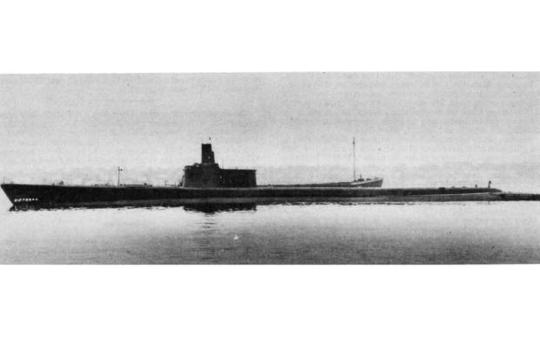


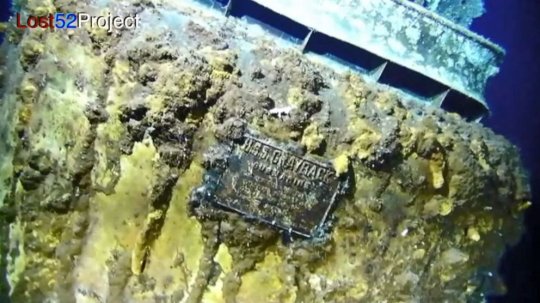
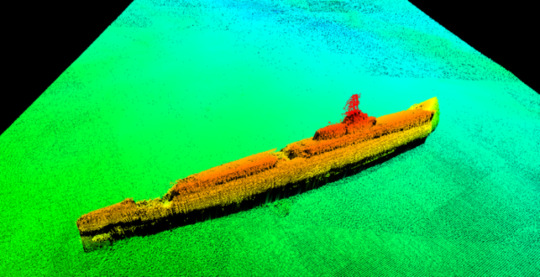
Long-Lost US Submarine From World War II Found off Japan
The long-lost wreckage of a U.S. Navy submarine credited with sinking nearly a dozen enemy ships during World War II before vanishing in late 1944 has been found off the coast of northern Japan, Navy officials announced Thursday.
The USS Albacore’s wreckage was confirmed by the Naval History and Heritage Command’s Underwater Archaeology Branch after it was located recently off the coast of Hokkaido, the northernmost of Japan’s main islands, the Navy said in a news release. The NHHC used information and imagery provided by Tamaki Ura, a University of Tokyo professor who has specialized in developing autonomous underwater vehicles to confirm the identity of the submarine. The Albacore disappeared while patrolling in the Pacific Ocean and had at least 85 sailors aboard.
“As the final resting place for [U.S.] sailors who gave their life in defense of our nation, we sincerely thank and congratulate Dr. Ura and his team for their efforts in locating the wreck of Albacore,” Samuel Cox, the director of the NHHC, said in a statement. “It is through their hard work and continued collaboration that we could confirm Albacore’s identity after being lost at sea for over 70 years.”
The Albacore was last heard from by the U.S. military on Oct. 28, 1944, when it stopped at Midway for fuel en route for its 11th combat patrol in the waters off northern Japan, according to Naval records. The Gato-class submarine was believed sunk in a Nov. 7, 1944, underwater explosion reported in Japanese military records, likely the result of hitting an underwater mine. The location of the ship’s wreckage appeared to confirm those details, according to the Navy.
Before the sub’s sinking, the Albacore had proved a capable warship. The vessel was built by the Electric Boat Company and commissioned into the Navy on June 1, 1942. The Navy credited the submarine with sinking at least 10 enemy ships during its brief tenure — earning the Albacore nine battle stars for meritorious participation in battle and four Presidential Unit Citations for extraordinary heroism in combat. The Navy said the Albacore might have been responsible for sinking three additional ships during the war, but those have not been confirmed.
Among the sub’s known sinkings were Japanese destroyers, freighters and the 31,000-ton Japanese aircraft carrier Taiho, then the newest and largest carrier in the Japanese fleet. Taiho sunk hours after being struck by a torpedo fired by the Albacore during the Battle of the Philippine Sea, according to the Navy. The Albacore’s crew did not know at the time that they had sunk the flagship after diving deep to escape incoming aerial attacks. Months later, the Albacore’s top officer at that time, Lt. Cmdr. James Blanchard, was awarded the Navy Cross, the service’s second-highest honor for combat heroics, for his role in sinking the Taiho.
The Navy said Ura used unmanned underwater craft to locate the Albacore based on Japanese records documenting the Nov. 7, 1944, explosion off Hokkaido.
“Strong currents, marine growth and poor visibility on site made it challenging to fully document the wreck or obtain comprehensive images,” the Navy statement said. “However, several key features of a late 1944 Gato-class submarine were identified in the video.”
Those features included the presence of a SJ Radar dish and mast, a row of vent holes along the top of the superstructure and the absence of steel plates along the ship’s upper edge consistent with the Albacore’s construction at the time that the submarine was last seen, according to the Navy.
The Albacore’s wreckage now falls under the NHHC’s jurisdiction and is protected from intrusion by U.S. law, the Navy said.
“The wreck represents the final resting place of sailors that gave their life in defense of the nation and should be respected by all parties as a war grave,” the Navy statement reads.
By Corey Dickstein.
#Long-Lost US Submarine From World War II Found off Japan#The USS Albacore#submarine#gato-class submarine#lost and found#ww2#war#world at war#weapons
25 notes
·
View notes
Text
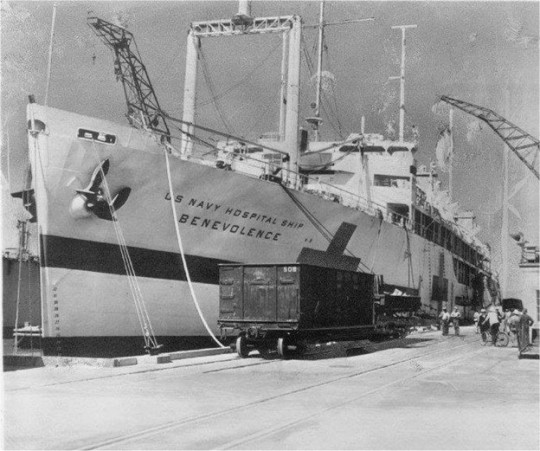
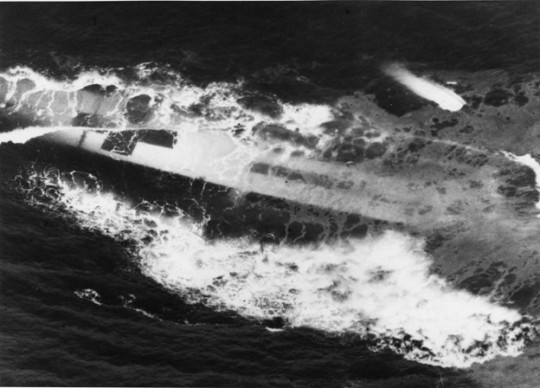
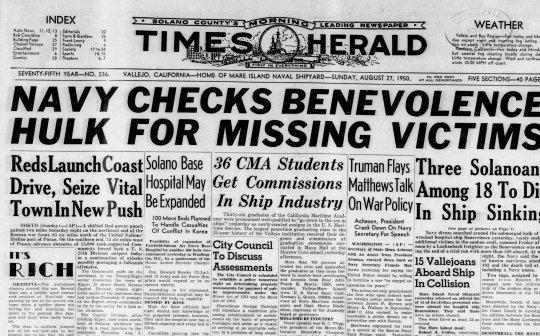
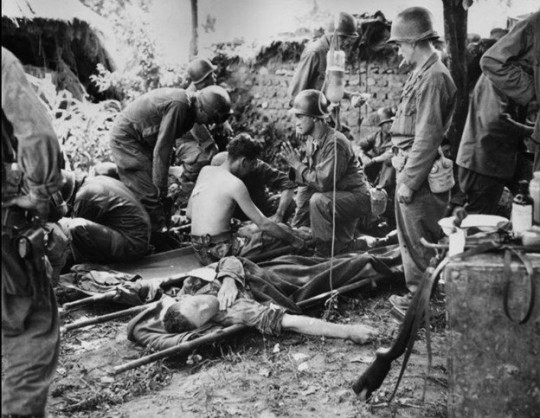
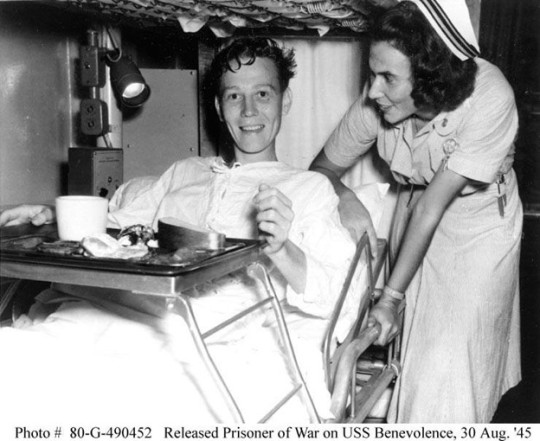

Life and Death at the Gate
At dawn on Sunday, 25 June 1950, the North Korean army crossed the 38th parallel supported by massed artillery fire. With the support of the Soviet Union the invasion was based on a false claim by North Korea that South Korean troops had attacked first. The real aim of the invasion was to take by force and subjugate South Korea under rule of the current North Korean leader's grandfather and his sham democracy. Condemned by the Free World, the invasion drew the first ever response by the United Nations, primarily supported by U.S. troops and aid. The war has technically never ended, and it resulted in millions killed and over 100,000 U.S. servicemen wounded or killed in action. In recognition of the coming carnage, a short time after the invasion, the World War II era hospital ship USS Benevolence (AH-13) was towed from a mothball fleet to Mare Island Naval Shipyard (MINS) in the San Francisco Bay Area to be taken out of mothballs and recommissioned. The US Navy Hospital Ship Benevolence would never make it to Korea. She tragically sank just minutes outside the Golden Gate while returning from sea trials.
Benevolence departed Mare Island at 0800 on 25 August 1950 for limited sea trials following recommissioning. Eight and a half hours later the fully loaded freighter SS Mary Luckenbac passed under the Golden Gate Bridge in thick fog bound for Philadelphia, Pennsylvania. Visibility was reported to vary from 300 to 400 yards. Radar had become common place by the 1950’s, but the Mary Luckenbac‘s radar had malfunctioned and was turned off. As the Mary Luckenbac passed under the bridge, she was on a collision course with the Benevolence returning from her sea trials. Aboard the Benevolence the radar was on and operating, but for some reason the crew was unaware of the approaching freighter. Both ships had bow lookouts posted and were operating their fog horns, but their combined closing speeds of 27 knots would doom the Benevolence. At an estimated 1,000 yards bow lookouts on the Benevolence sighted the bow wave of the approaching freighter. Benevolence began blasting the emergency signal on the ship’s horn as both ships attempted evasive action. It was too late, within three minutes the freighter slammed into the hospital ship raking her compartments open along the port side.
Following the collision both ships vanished into the fog. Unaware of the extent of the damage to his ship, Captain Barton E· Bacon on board the Benevolence gave no orders to prepare to abandon ship. However, within 5 minutes his ship’s main deck had sunk to sea level at the bow and she was listing 45 degrees, too far over to launch the lifeboats. The Benevolence had managed to transmit a message requesting emergency assistance just after the collision and then radio contact was lost. Twenty minutes later the Benevolence rolled over and sank in the shipping channel between Pt. Bonita and Seal Rocks. Five Hundred and twenty-five men and women went into the frigid water as the outgoing tide scattered them further out to sea. As word of the disaster spread a small armada of fishing boats, yachts, coast guard and naval vessels began scouring the seas in the thick fog looking for survivors. Survivors would continue to be found and pulled from the sea for nearly two days and as they were landed by rescue ships the Red Cross handed them a carton of cigarettes and the Service’s gave them booze. In the end eleven Navy, ten Military Sea Transportation Service and two MINS tradesmen were lost.
The Benevolence laid just beneath the waves in the south shipping channel as a hazard to navigation for sixteen months as separate courts of inquiry were held by the Navy and Coast Guard on Treasure Island and in San Francisco respectively. While the inquiries were underway MINS was directed to study the possibility of salvage. A no cure no pay request for proposals was sent to Bay Area salvage firms to evaluate the feasibility of salvage. A tanker suffered a minor collision with the Benevolence hulk, before MINS officials determined that salvage was not feasible, and the decision was made to remove the hazard with explosives. When you visit the USS San Francisco memorial near Lands’ End on the 49 Mile Scenic Drive and look out to sea you are overlooking the site of the Benevolence sinking.
Dennis Kelly
#mare island#naval history#san francisco bay#us navy#vallejo#Korean War#Mary Luckenbac#Benevolence#Hospital Ship#Golden Gate#sink#collision#fog#survivor#drown
2 notes
·
View notes